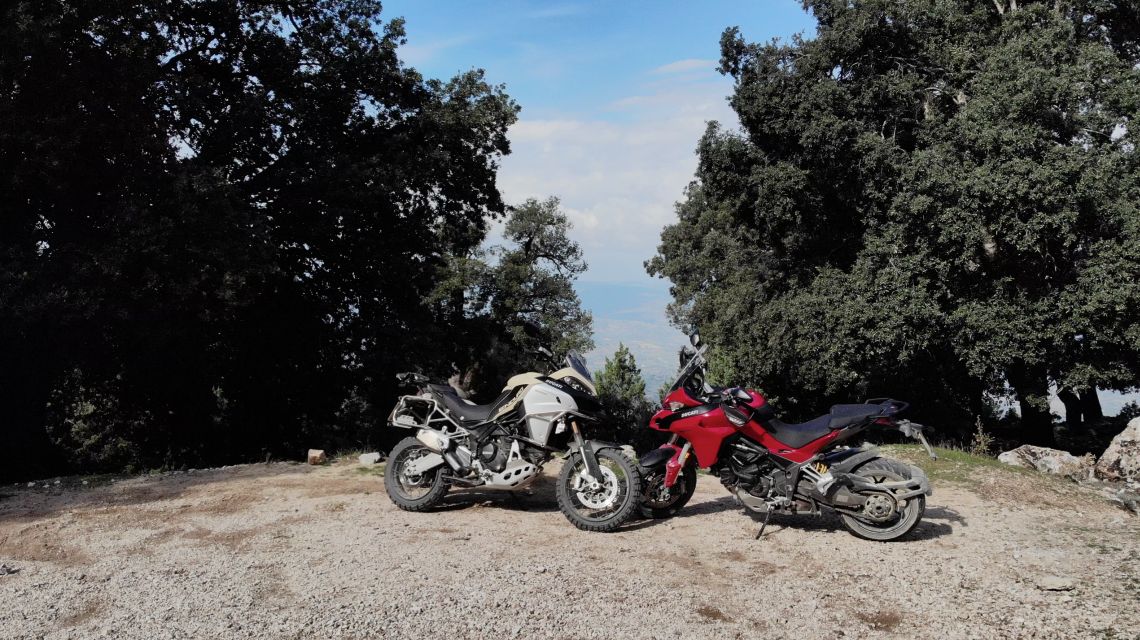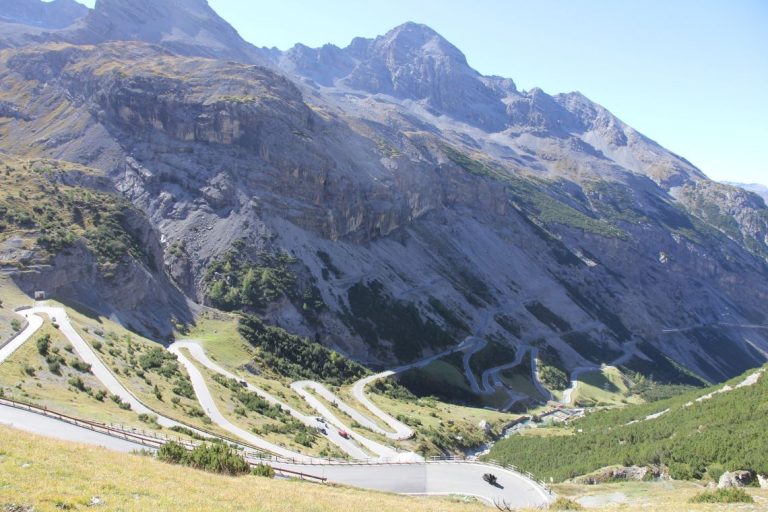Words and Pictures: Alun Davies, Bryn Davies
High mountain passes, spectacular coastal roads, twisty country single tracks, history, culture, superb food and drink, and then there’s the unrivalled magnificence of the Dolomites. Is Italy Europe’s finest motorcycle touring destination? You bet! Adventure Bike Rider and its sister title Adventure Travel (AT) magazine have a long history when it comes to touring the roads and trails of Italy.
Back in the days when I was editor of AT and mountaineering and hiking were as important to me as riding motorcycles, I’d spend whole summers driving and sometimes riding the more remote and mountainous areas with outdoor gear strapped to the pillion looking for interesting lumps of rock to climb and trails to hike. I’d spend my evenings writing up reports and emailing them back to the office.
Then, once every six weeks, I’d park the van or bike at an Italian airport, fly back to the UK and add the finishing touches to the magazine before sending it to print. And then I’d fly back and do it all again.
I followed this way of life for three consecutive summers which resulted in outdoor guides, regional hiking guides and the first ever documented report of all the via Ferrata climbing routes in the Dolomites. To say I was in awe of the country would be an understatement and I would have happily moved to and settled in Italy for the rest of my life.
Since the launch of ABR magazine and an accident that curbed my climbing career, I’ve been back to Italy as much as possible to enjoy the spectacular roads, trails, scenery, history and culture by motorcycle. These more recent trips, added to my prior knowledge, have helped shape this touring guide to bring you the best of what we at ABR consider Italy has to offer.
There’s not enough space in these pages to detail everything I’d have liked to, but what we have done is divided the country into six areas that could be toured independently or combined into a longer trip. Then we’ve provided ideas and information and focused on one or two highlights in each region with a view to inspiring you to go and have the motorcycle tour of your life.
We documented a trip around Italy visiting all six of these areas, creating a mini-series of videos along the way, so head on over to our YouTube channel (www.youtube.com/ABRmagazine) to check them out. Addio, and safe riding
Alun Davies
Founder of Adventure Bike Rider and Adventure Travel magazines.
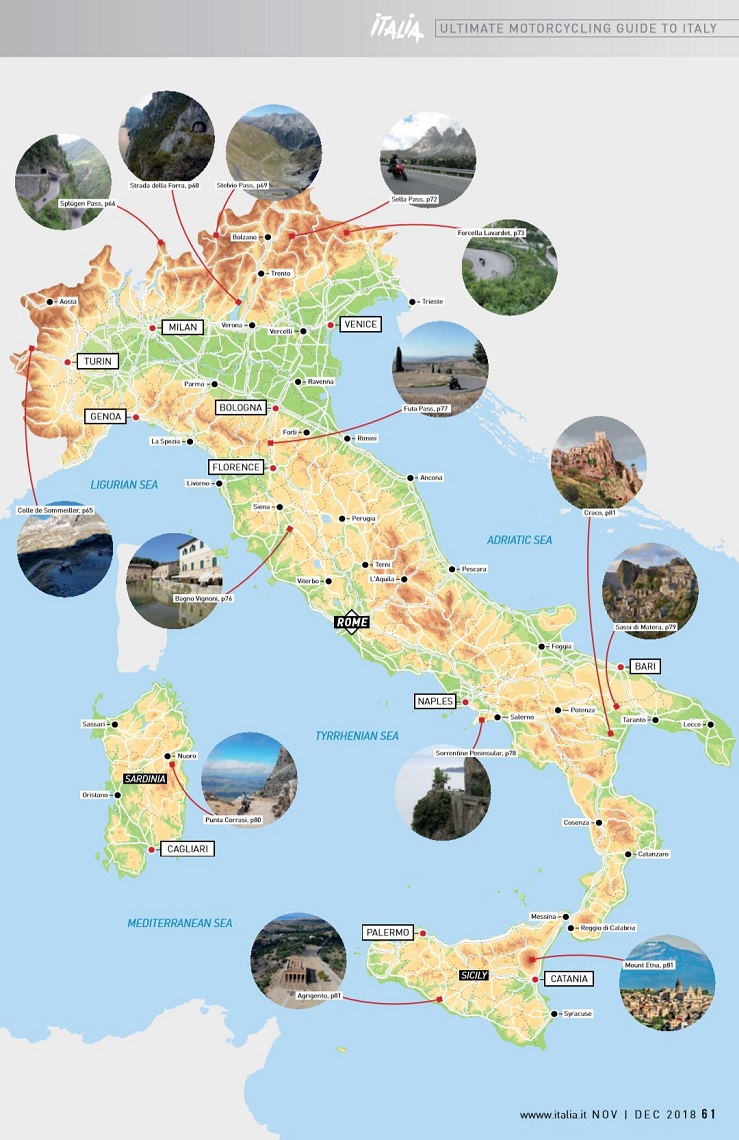
The Northwest
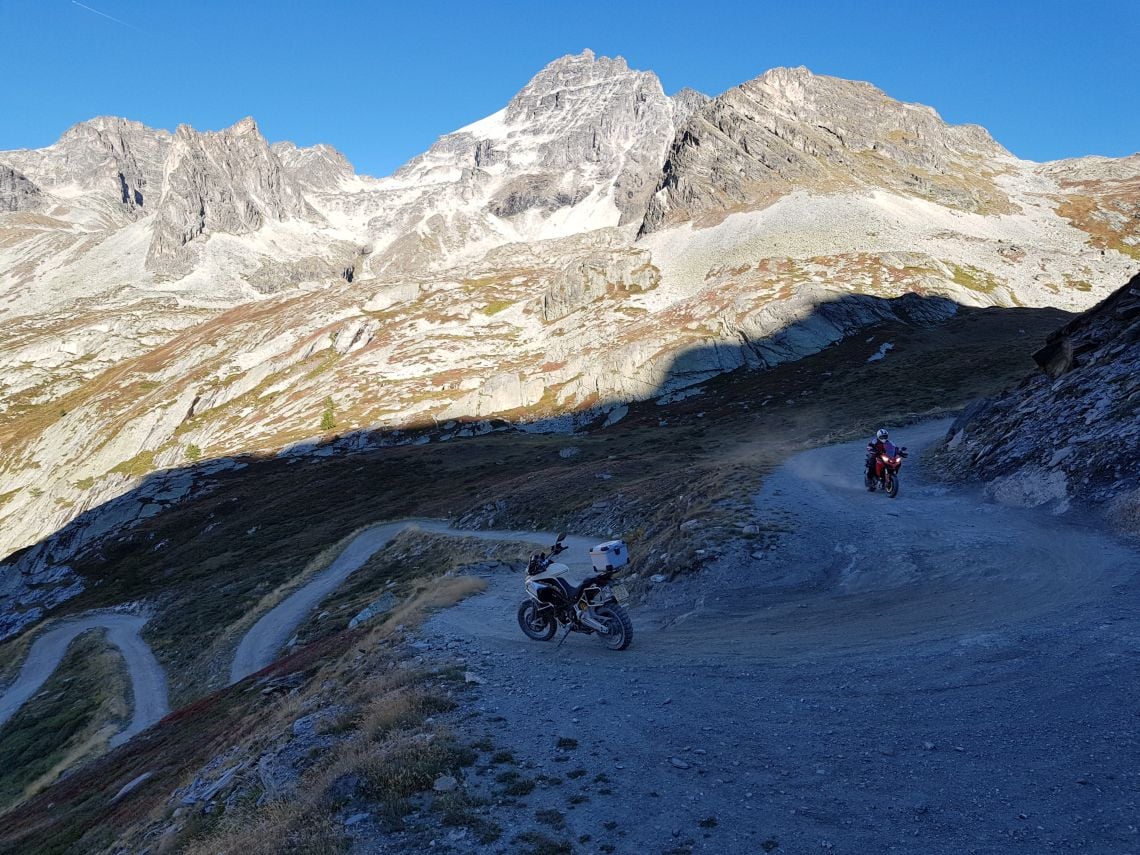
Liguria, Valle D’Aosta and Piedmont
From Sanremo and Genoa on the Mediterranean Coast to the high peaks of the Aosta Valley, the Italian North West has it all. There’s great off-road adventure riding to be found on the Alpine military roads and some of the best road touring passes and scenery in Europe.
Where is it?
Butting up to France and Switzerland, the Italian North West consist of three regions; the coastal strip of Liguria, the Alpine region of Valle d’Aosta on the northern border and the larger region of Piedmont sitting in-between and offering a variety of mountains, lakes, plains and big cities.
For the UK rider, there’s a good chance you’re going to start your tour of Italy in the northwest of the country. All three of the northwest regions (Valle d’Aosta, Piedmont and Liguria) have main road links with either Switzerland and France, with the tunnel under Mont Blanc, or Monte Bianco as it is known in Italy, being the nearest border crossing to the UK.
Our favourite entry point in this northern region is the Col du Petit Saint Bernard (The Little St Bernard Pass), which starts out as the D1090 from Bourg-Saint-Maurice in France and ends as the SS26 in the Aosta Valley just south of Courmayeur.
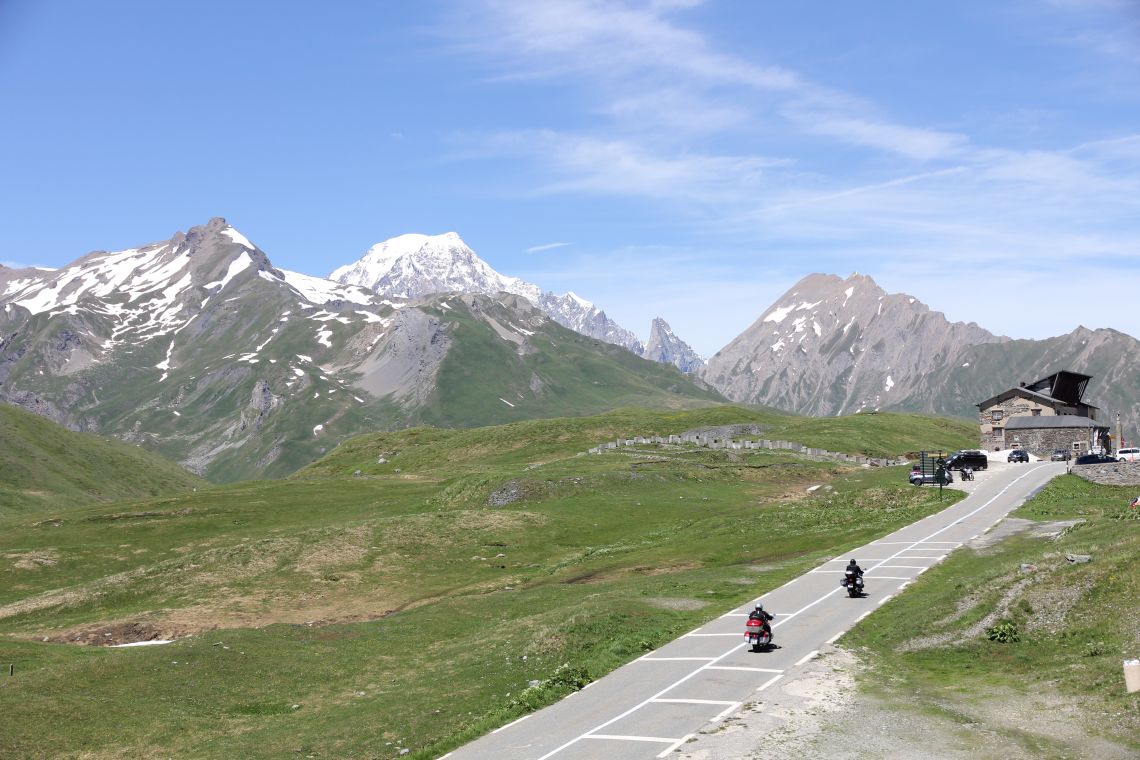
The Little St Bernard Pass is a thrilling road and offers the rider unparalleled views of Mont Blanc, Western Europe’s highest mountain which tops out at a glaciated 4,810m. From the Chamonix Valley in France, Mont Blanc is one of the less dramatic peaks in the massif appearing as a benign, rounded white dome.
However, it’s all change on the Italian side where it becomes one of the most dramatic and savage mountain vistas in the Alps, and there’s no finer view of the wild and precipitous ridges and glaciers than that offered from the SS26.
And whilst not conclusively proven, the pass is thought by many historians to be the route followed by the Carthaginian general Hannibal when he led his army into Italy in 218BC. Something for you to mull over as you hit the switchbacks.
Heading down the Aosta Valley towards Turin and Piedmont, you’re flanked on the left (north side) by some of the highest peaks in the Alps, including the Grand Combin (4,314m) and the only mountain in the world that’s had a chocolate bar cast in its image – the spectacular and unmistakable Matterhorn (4,478m).
The Aosta Valley offers outstanding natural beauty and fantastic Alpine passes, but it is also a region packed with interesting and historic architecture such as Savoia Castle, Fénis Castle and many Roman monuments and museums.
Plus, there are colourful festivals and carnivals throughout the year and if you’re lucky to be riding through when the Pont-Saint-Martin carnival is taking place, you’ll be able to check out the chariot races.
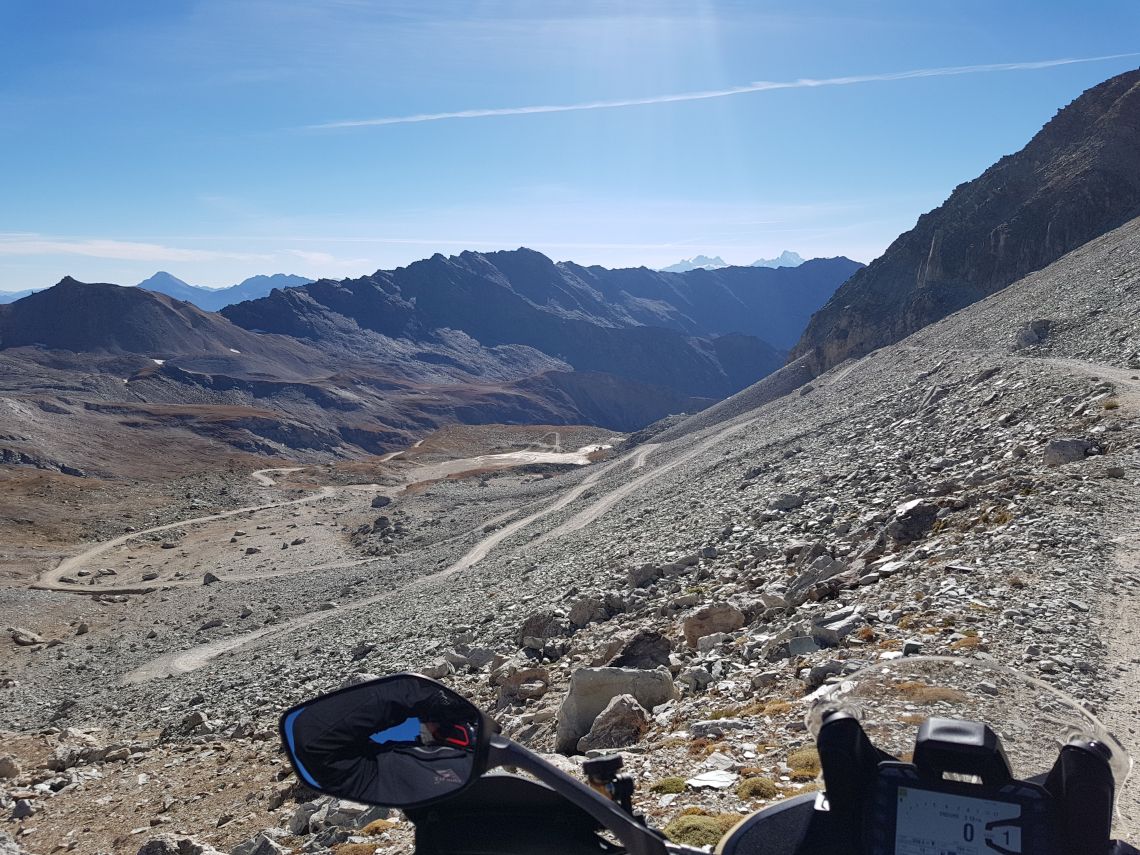
Continuing further east into Piedmont, there are plenty of attractions to keep you in Italy, not least the spectacular roads and scenery surrounding Lake Maggiore, but it’s inevitable that you’re going to nip over into Switzerland at least once to check out one or more of the famous Alpine passes such as the Simplon or Gotthard.
Heading back to Mont Blanc and riding south from Valle d’Aosta, you’ll find that the Alps form a continuous and formidable barrier right down to the Mediterranean coast with the next major crossing being the Cenis Pass (Col du Mont Cenis) at 2,083m. Historically, the route was an important trading path, and by 1810 Napoleon had built a road over the pass.
The Cenis Pass is also our recommended route for avoiding the expensive Fréjus Road Tunnel, which connects Modane in France to Bardonecchia in Italy – see the next page on the Colle del Sommeiller for more information on Bardonecchia.
South of Bardonecchia, right down to within sight of the Mediterranean, both the road touring and off-road adventure riding is superb and it’s almost inevitable that you’ll find yourself crossing into France riding one of the major or minor passes or when checking out the old military roads.
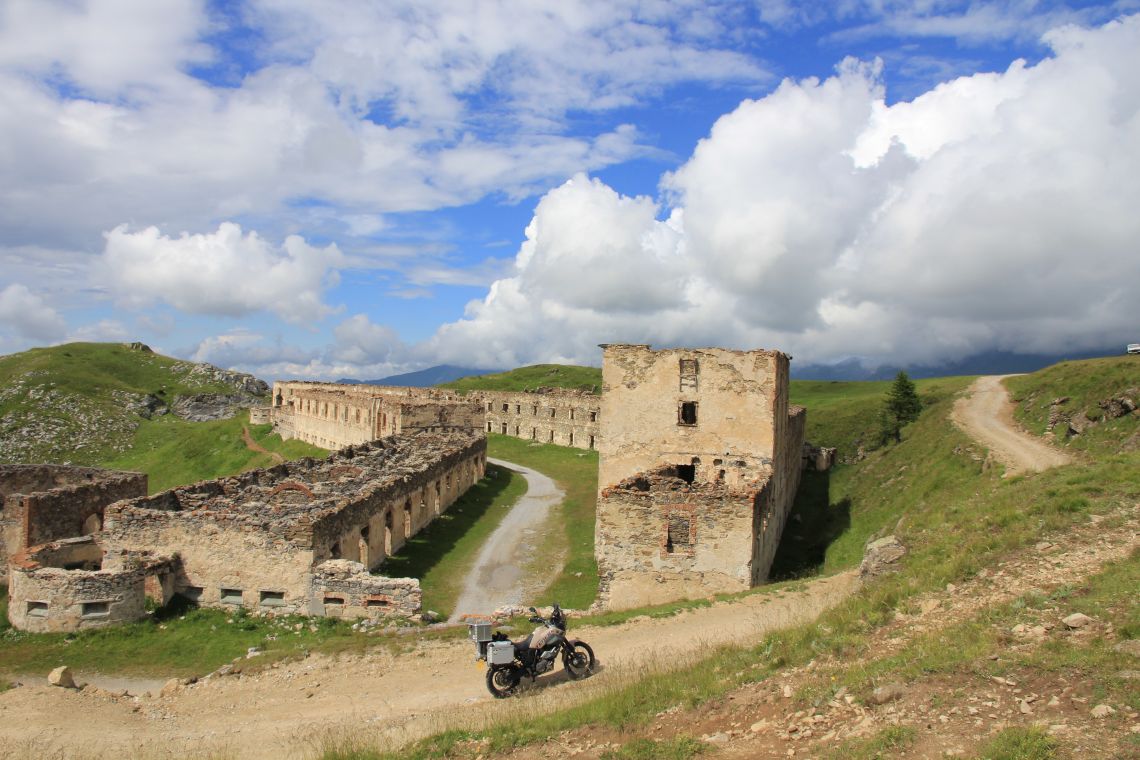
These military roads were constructed to serve fort and gun positions along the high Alpine ridges of the French/ Italian border. Most are unpaved and quite a few are off limits to motorised vehicles and in disrepair, but there are still plenty of them that are open to, and accessible by, motorcycle.
Our favourite spot for riding military roads is just to the south of Cuneo on the old road cresting the Col de Tende. Whilst these trails make for spectacular riding, be warned that you’re a long way from help, and even a telephone signal, should you have problems on these off-road trails.

If you ever tire of the fantastic mountain roads in the northwest, then a visit to Turin is rewarded with numerous art galleries, palaces, opera houses, parks, gardens and classic architecture.
Alternatively, a ride down the old Mediterranean coastal road from the border with Monaco to the Cinque Terre peninsula near La Spezia is worth a blast. Whilst it’s a busy route in summer, it makes for a great 186-mile tour of the Italian Riviera and the spectacular coastal villages of the Cinque Terre are not to be missed.
High passes in north-west Italy you must ride:
Col du Nivolet (2,641m) – Near Ceresole Reale and the scene of the bus crash in the Italian Job.
Colle Fauniera (2481m) – Near Marmora, the pass is also known as ‘The Pass of the Dead’ due to the fierce fighting that was seen here between the Franco-Spanish and Piedmontese troops in the 17th century.
Col de la Lombarde (2350m) – Near Vinadio in the Maritime Alps
Highlight: Colle del Sommeiller
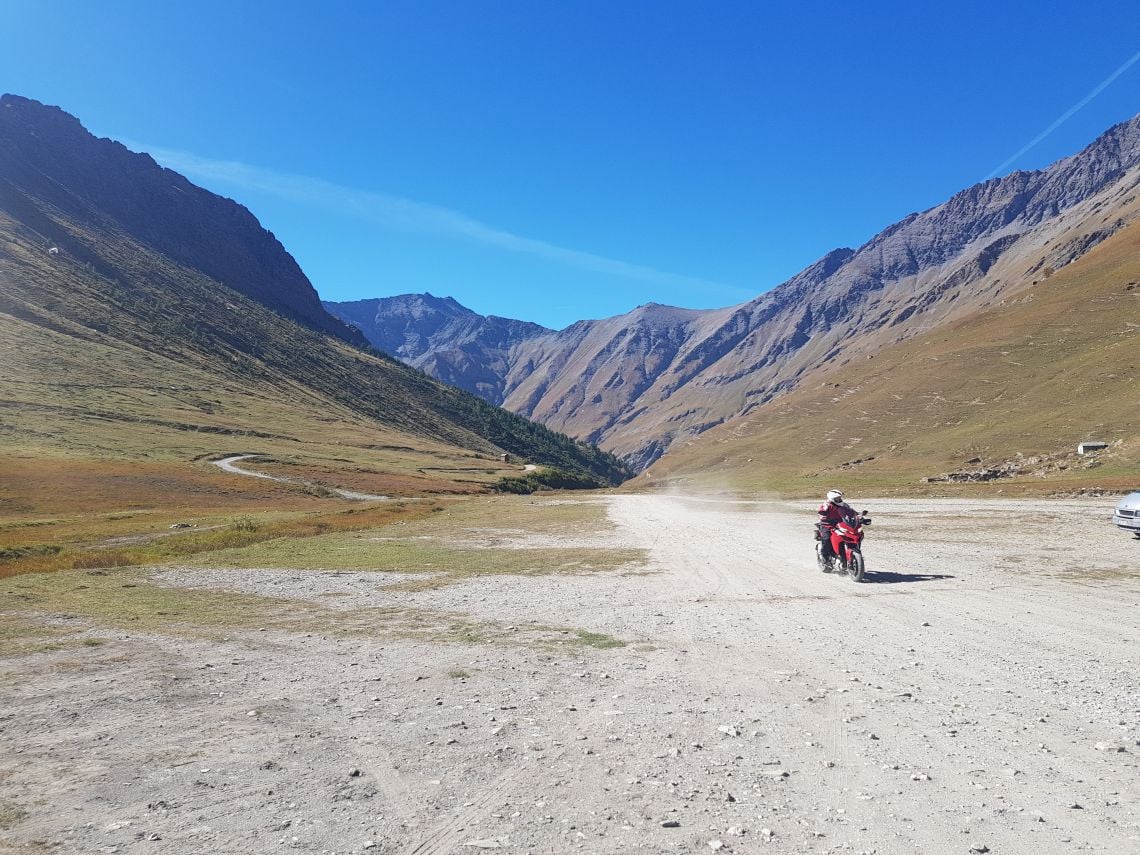
The Italian Alpine town of Bardonecchia is famous in motorcycle circles for two reasons; it’s the venue of the famous Stella Alpina (Stella Alpina Motociclistica Internazionale ) adventure rally and the 17-mile long trail to the 2,993m-high Colle del Sommeiller. There are higher trails in the Alps, but most are now closed off to motorised vehicles or a lot more difficult to ride.
The rally and the colle are intrinsically linked. Socialising aside, the objective and main focal point of the rally is to ride as high as is safely possible up the Colle del Sommeiller, a gravel mountain pass that tops out at 2,993m above sea level.
Due to the altitude, it is not uncommon for late lying snow to hamper the efforts of those who attempt it, at which point the ride is considered to be ‘done’ at a lower altitude before things get too dangerous.
Speaking of which, I’ve attempted the ride up the Colle del Sommeiller on three occasions and it was only the last time, in the making of this guide and accompanying video, that the conditions allowed a successful summit.
On both previous occasions, the snow level was below the colle and far too extensive in cover and soft in composition to reach the fabled summit. At a guess, I reckon we got to within 100 vertical metres of the summit on both prior occasions and thoroughly enjoyed the ride.
From Bardonecchia, the route up the Colle del Sommeiller follows a narrow, twisty tarmac road to the small village of Rochemolles. There, the tarmac ends and the gravel trail begins with a series of zig-zags before levelling out alongside the Lago di Rochemolles lake and dam.
The trail carries on to the head of the valley and the Rifugio Scarfiotti which is open during the summer months and offers good food and welcome refreshments. From the refuge, the fun begins with a series of steep zig-zags carved into the mountainside which leads onto a higher plateau.
Whilst the ride to the refuge is considered non-technical and easy enough for the vast majority of riders, even those on road bikes, the series of hairpins above can be a little daunting for the less experienced. Many rally-goers are more than content to call it a day at the refuge and watch the spectacle unfold up above.
There is little in the way of technical difficulty above the hut, but the zig zags are very tight, steep and covered in gravel and loose stone, and you’ll need to be comfortable riding along a narrow, single-track trail with steep drop-offs alongside.
The rewards for gaining the high plateau above the zig-zags are the spectacular views and just the sheer enjoyment of being able to ride a motorcycle in such a jaw-dropping environment.
From the plateaux to the colle there’s a further sequence of gravel and rock-strewn zig zags (the rocks here are larger and looser than those that you rode a few miles downhill), which can hold snow well into the summer months.
The Stella Alpina takes place in Bardonecchia on the second Sunday of July each year and is attended by hundreds if not thousands of riders, so you’ll not be short of company.
The Central Italian Alps
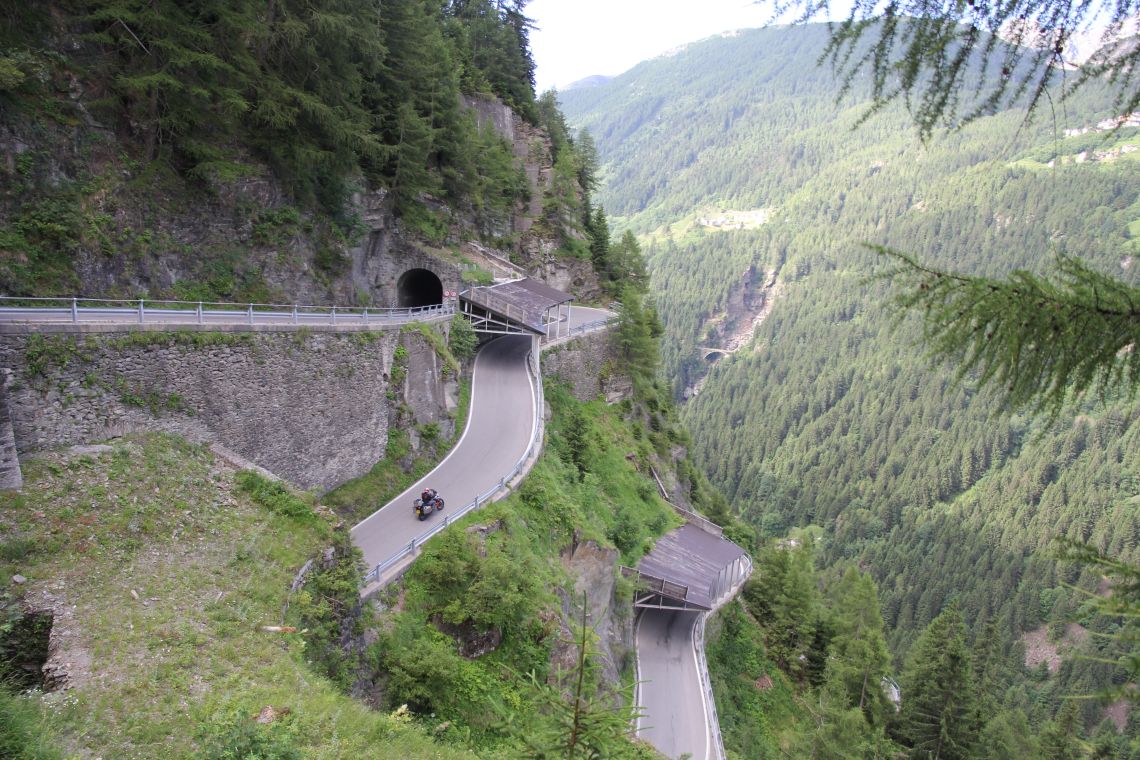
Lombardy
Spectacular Alpine passes bordering Switzerland, the Italian lake district and the lowlands of the Po Valley all characterise the wonderful Central Italian Alps. From the eastern coast of Lake Maggiore, taking in Lake Como and Lecco to the dramatic high cliffs on the western coastline of Lake Garda, the Central Italian Alps feature some of the best road touring and tourist-friendly regions of Italy.
Where is it?
The Central Italian Alps consists of a single region, Lombardy. Lombardy stretches from the border with Piedmont in the west at Lake Maggiore, to the shores of Lake Garda in the east. The northern Alpine border is shared with Switzerland whilst, in the south, Lombardy extends beyond Milan and Brescia into the extensive flatlands of the Po Valley.
Lombardy is certainly a region of contrasts, offering motorcyclists a rich choice of spectacular mountain passes and roads, beautiful Lakeland scenery, cities rich in culture and history plus it’s a region with a strong motorcycle background, with MV Augusta and Moto Guzzi being local residents.
Ask a group of bikers to name their favourite Alpine passes and you can be sure that either the Splügen or Stelvio will feature. Topping out at 2,757m above sea level, the Stelvio is the highest paved pass in Italy and second highest in the Alps, whilst the Splügen takes an audacious line across and down vertical precipices complete with balcony sections which were cut from the rock back in 1823 (as shown in the image above).
Having travelled extensively by motorcycle over the past 40 years, I can tell you now, one of the finest motorcycle day rides in the world is to be found in Lombardy – with a brief detour over the border into Switzerland.
Starting off at the Splügen Pass and calling it a day at the Tonale Pass, where Lombardy meets Trentino, the route is 176 miles of Alpine and motorcycle heaven. I guarantee that you’ll spend the day gasping at the natural scenery, which makes this journey such a pleasure, and in awe of the stunning engineering accomplishments which have made this ride possible.
I’ve ridden this route many a time and I never tire of the ride. Starting off at the Splügen Pass, you’ll find yourself wanting to stop every 200 metres or so to check out the stunning line of the road and the precipitous drops down into the valley.
After a brief stop to catch your breath and a coffee in Chiavenna, it’s a quick blast up the Bregaglia Valley and over the Maloja Pass into St Moritz before turning south-east back into Italy on the road to Tirano.
At Lake Bianco, under the glaciated 4,048m peak of Piz Bernina, you take the mountain road over to the Italian ski resort of Livigno where I like to stop and fuel up with another Italian coffee. From Livigno it’s a quick blast back over the Swiss border and down to the village of Glurns before heading south-east to Stilfs and the magnificent northern approach of the Stelvio Pass.
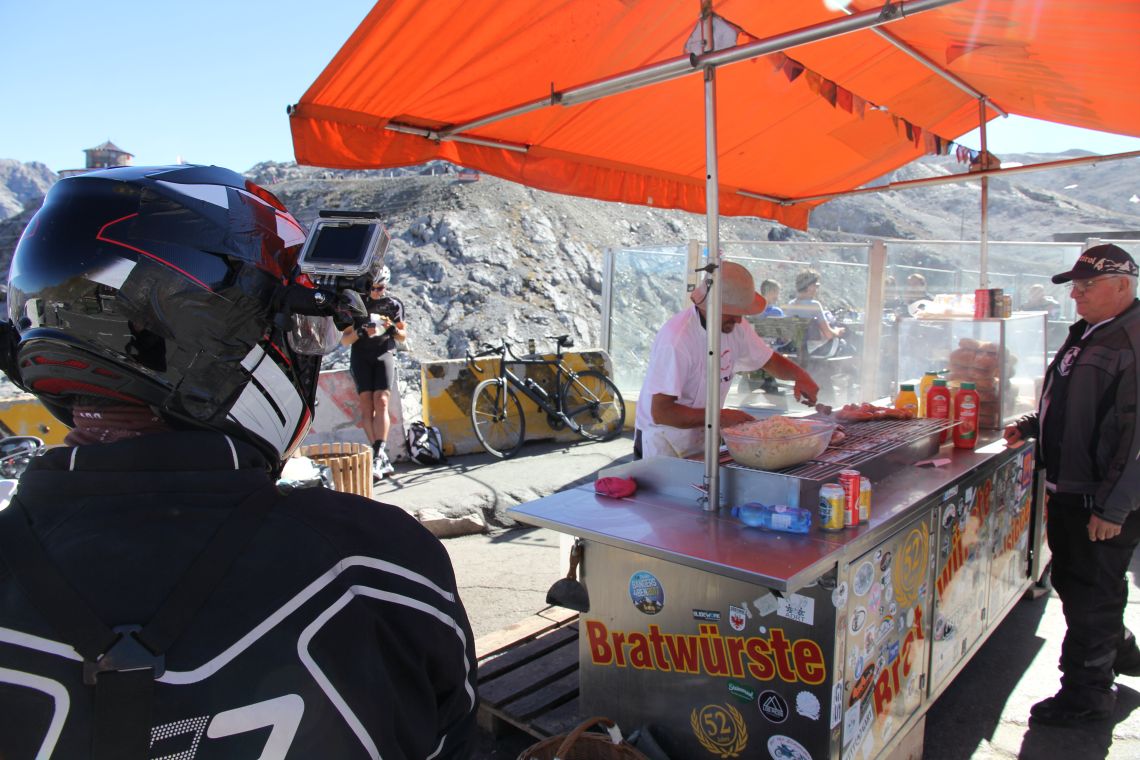
At the top of the pass, it’s a bit of a biker tradition to stop and have a bratwurst from one of the stalls and take in the spectacular views over the glaciated Ortler Range. Whilst the northern approach to the pass is a relentless procession of tight hairpins, the ride down the southern side to Bormio is more open but no less spectacular or demanding.
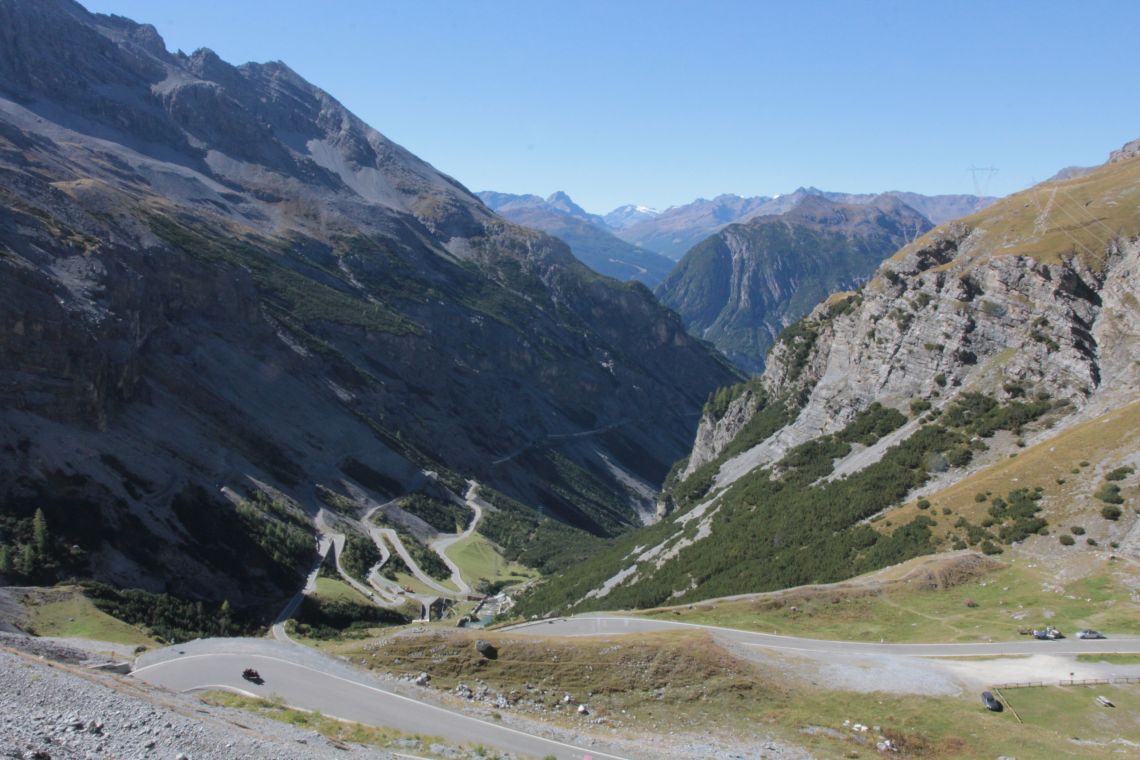
From Bormio a left turn takes you up and over one of the most unsung passes in Italy, the Gavia Pass. The pass is mostly single track through spectacular scenery, features multiple switchbacks and it’s very popular with bikers.
At 2,621m high it’s also the third-highest pass in Italy, and many a motorcyclist will tell you the riding experience is better than that found on the Stelvio which can, in the main summer season, be very busy.
Speaking of which, I’ve ridden both these roads in mid-summer and early October and, if you get the weather (we had bright blue skies), early October is a great time to tour with far less traffic on the roads.
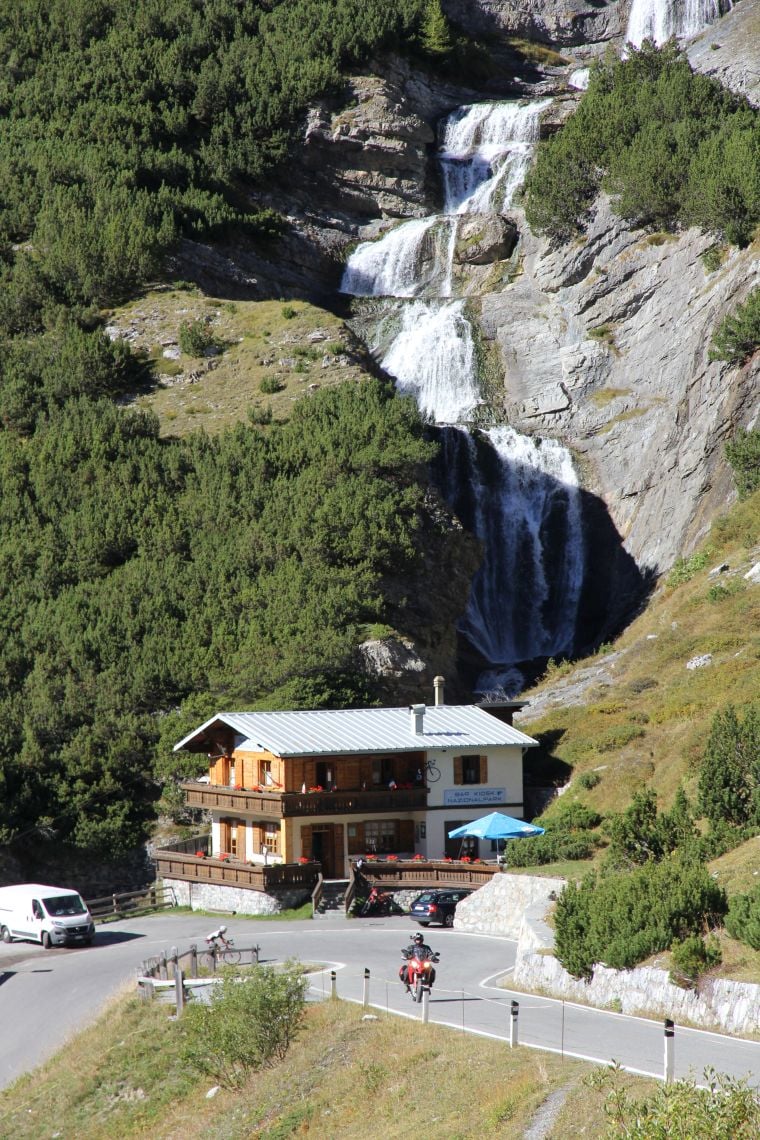
The Gavia Pass road hits the main SS42 highway at Ponte di Legno where you can open up the throttle on the superb curves leading to the Tonale Pass. You’ll find plenty of hotels and cafes at the Tonale Pass and it’s a good place to overnight before pressing on to the Dolomites in the morning.
There’s no doubting the draw of high Alpine passes to motorcyclists, but no tour of Italy can be complete without taking in one of the many lakes to be found in Lombardy. Lake Como is probably the best known and offers both great riding and magnificent scenery, as does Lake Maggiore and the smaller Lake d’Iseo.
However, given the choice, I prefer to head further east and onto the road up the western coast of Lake Garda. If you’ve only visited the flat southern shore of the lake, then you don’t know what you’re missing.
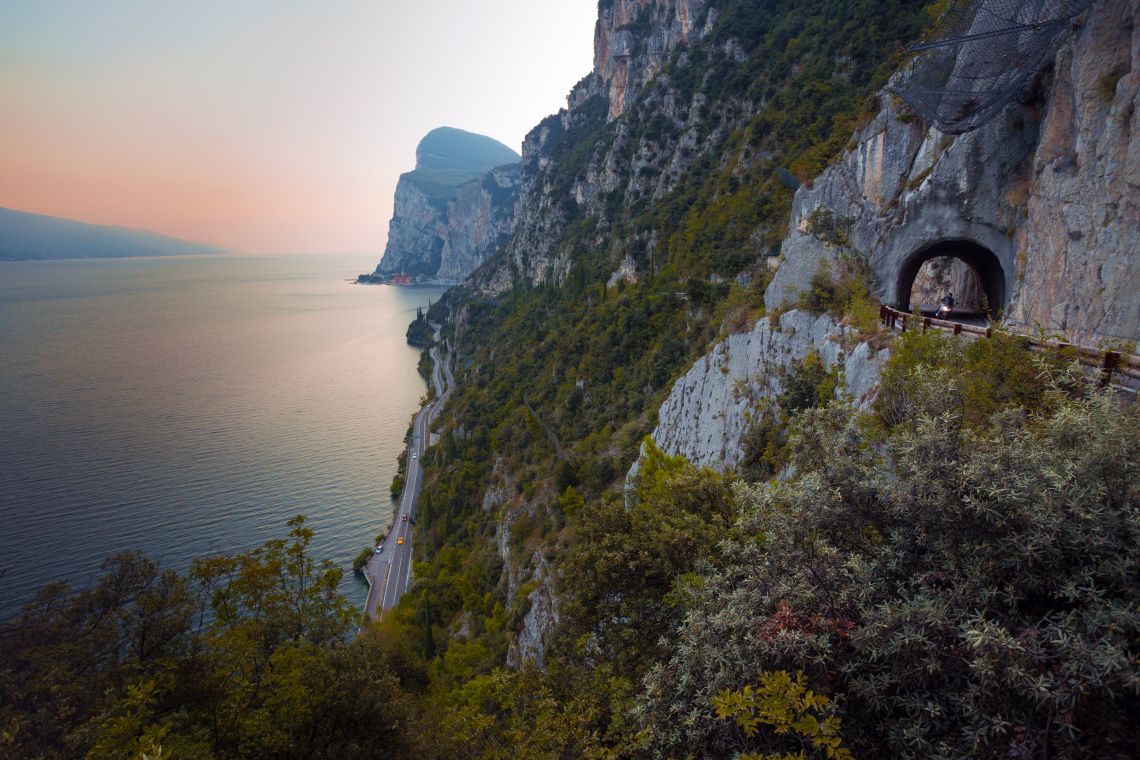
One easy way to check out what you’ve been passing up on is to watch the opening scene in the James Bond film Quantum of Solace where the bad guys chase Bond along the road skirting the Lake Garda shoreline.
If you find yourselves in these parts, do not leave until you ride the incredibly spectacular Strada Della Forra road, which Winston Churchill defined as the Eighth Wonder of the World.
Before leaving Lake Garda, I’m going to recommend you take the SP9 from the village of Gargnano over to Lake d’Idro, it’s just one of those scenic local roads you’d never think of taking but will always remember riding.
Highlight: The Stelvio Pass, 2,757m
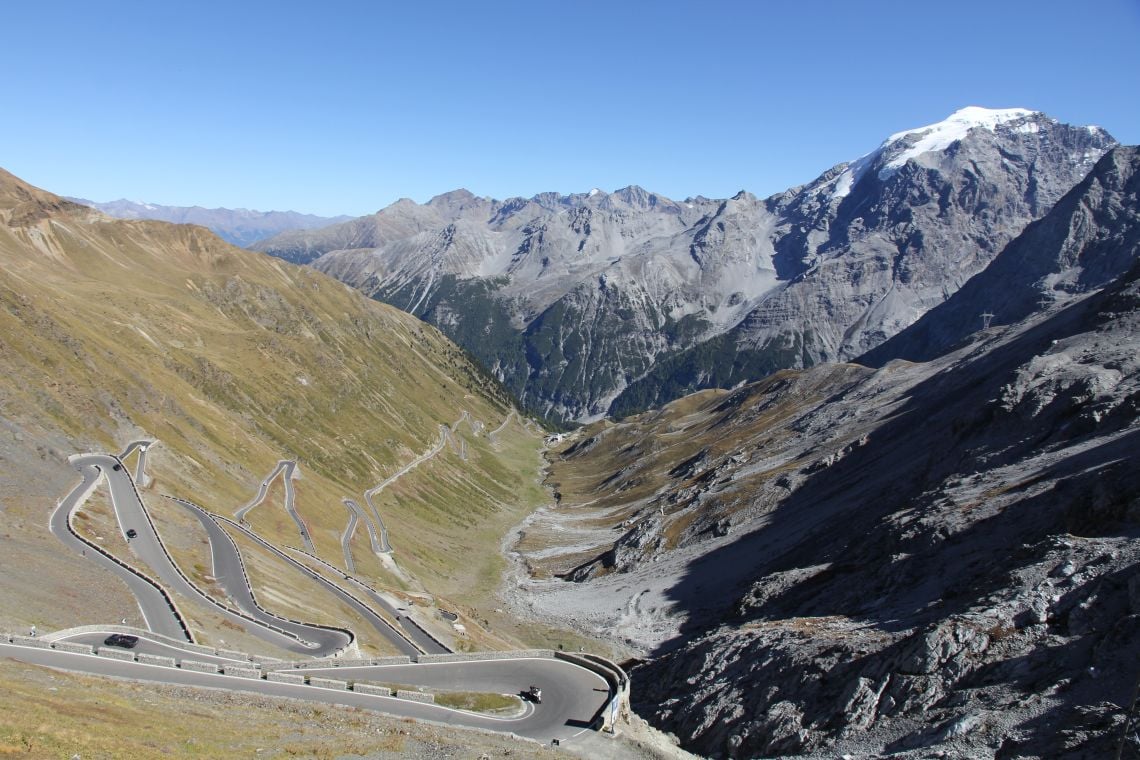
If Carlo Donegani had re-routed his original plans a little to the left or right and, in the process, picked up an extra 7m of elevation the Stelvio would now hold the throne as the highest paved mountain pass in the Alps. That claim goes to the French pass the Col de l’Iseran, which tops out at 2,764m.
As it stands, the Stelvio is the highest paved mountain pass in the Eastern Alps, cutting through the Ortler Range, a glaciated mountain range I’d long admired during my climbing days. Ortler, the highest summit in the range, stands at 3,905m above sea level, which means it’s just below the 4,000m mark demanded by serious Alpine peak baggers.
What’s probably more interesting is that the peak contains the highest ‘trench’ in military history, which was hacked out of the main glacier at 3,850m by Austrian troops during World War One.
It was only in the mid-1990s that a mountain guide ‘discovered’ the two World War One cannons just below the summit which had been covered by snow since 1918. That’s something for you to ponder over as you look out over the snow and ice-bound summit of Ortler from the crest of the Stelvio Pass.
It was an ascent of the Ortler, coincidently in the mid-1990s, that first brought me into contact with the Stelvio. I arrived at the northern approach in early June to find signs warning that the pass was closed due to snow.
With the start of the climbing route in Trafoi, about halfway up the pass, I decided to chance it. I can remember thinking at the time ‘I just have to come back here on a motorcycle’ and that was way before the TV show Top Gear picked the Stelvio Pass as its choice for the ‘Greatest driving road in the world’.
The original road was built between 1820 and 1825, and it still follows the primary route as of today.
The pass runs for just over 24 miles from Gomagoi in the north to Bormio in the south and is famed for the 75 hairpin turns, of which 48 are on the northern approach. There’s no doubting the riding can be tense and gripping with so many switchbacks coming one after another, but the spectacle of the road carving its way up the steep-sided valley is one that should not be missed.
At the top of the pass, it’s tradition to stop and have a coffee and a bratwurst from one of the many stalls and cafes. I guarantee you will not be alone, this is as close to a riding mecca as you’re going to get in the Alps.
The ride down the southern side to Bormio is less committing when it comes to switchbacks and, in a lot of respects, it could be said to offer better, or should I say smoother, riding. Don’t let that fool you, though, it can be just as exciting and there are great opportunities for you to check out the scenery as opposed to lining up the next 360 bend.
Eastern Alps and The Dolomites
Trentino-Alto Adige, Friuli-Venezia Giulia and Veneto
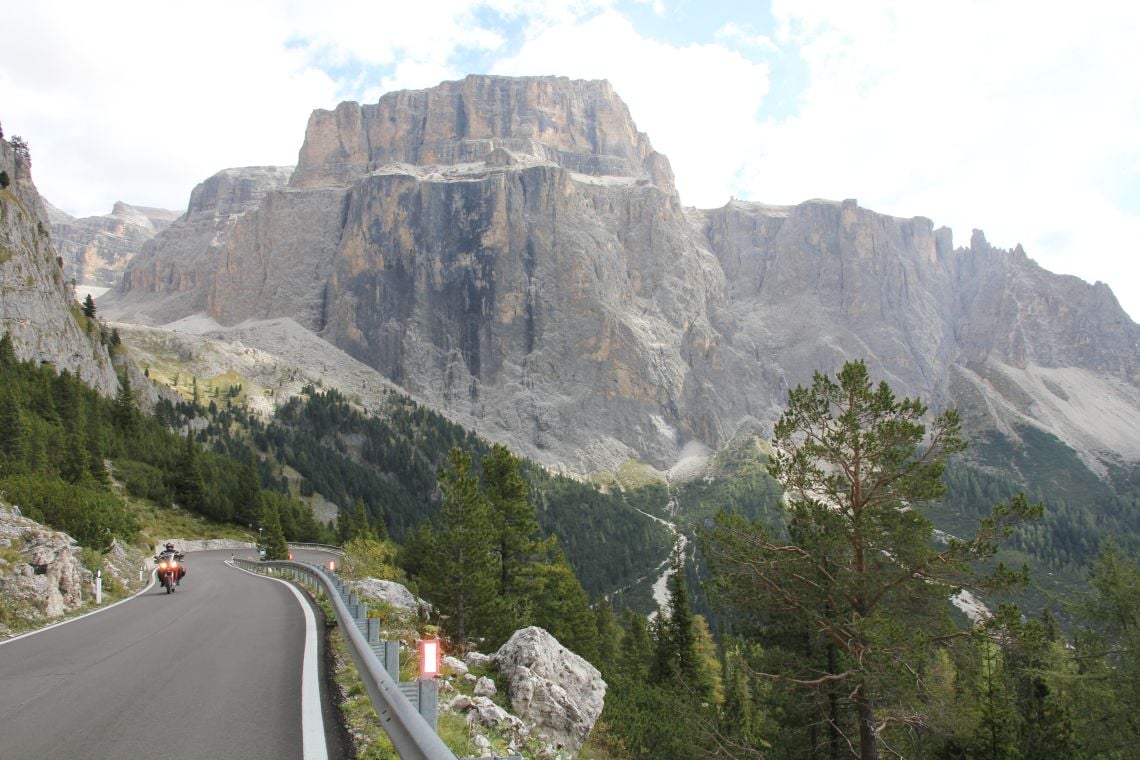
The north-eastern region of Italy has it all; high glaciated peaks, the spectacular Dolomites, plus the historically and culturally rich lowlands of Venice and Verona. Just passing through is not good enough, you’ll miss out on some of the most spectacular roads and scenery in the world… and we’re not just being sensationalist there.
Where is it?
The Italian regions of Trentino-Alto Adige, Friuli-Venezia Giulia and Veneto stretch from the Swiss border in the west to the Slovenian border in the east. It’s no hyperbole when I say they contain some of the most dramatic mountain scenery in the world plus there’s the rich culture and spectacular cities of Venice and Verona.
If I could choose only one destination to tour on a motorcycle, then the northeast corner of Italy would be it.
In my view, the Dolomites and surrounding mountain ranges are unparalleled when it comes to jaw-dropping scenery and equally spectacular roads. The jagged limestone towers and huge precipitous cliff faces are surreal in both scale and setting, and the good news is that there are roads to take you to every corner of this magnificent area.
If you’ve never been to the Dolomites and need a quick fix of what’s on offer, check out the opening scene in the Silvester Stallone film Cliff hanger. The story may be set in the USA’s Rocky Mountains but, when it came to the filming, they shot the dramatic scene in the Dolomites, near the town of Cortina.
I’d imagine most riders from the UK will enter the northeast region either via the Brenner Pass from Innsbruck or via the Resia Pass from Nauders, both in Austria. If via the latter, then I’d advise you check out the Central Alps and continue via the Stelvio, Gavia and Tonale Passes and onto Madonna di Campiglio, which is a fine place to over-night.
During my climbing years, the jagged Brenta Dolomites overlooking the town were my go-to mountains. However, unless you’re feeling in the mood for a spot of hiking or climbing, my route suggestion here heads south to Ponte Arche and then north through Andalo and onto Cavareno.
These are all fine roads through spectacular scenery and there are more apple orchards than you’ll be able to count. The twisty road from Cavareno to Bolzano offers fantastic views over the Trentino Valley and the main Dolomite region beyond.
From Bolzano to Canazei in the Fassa Valley you can’t take a bad road, but I’m going to advise you to seek out this little gem of a route we discovered on our recent trip. Take the SS12 out of Bolzano heading northeast until you reach the small village of Prato Isarco Blumau and take the side road to Collepietra – the LS132.
We would never have found this road unless the tunnel on the main SS241 out of Bolzano was closed, but we sure are glad that we did. It’s a fantastic bikers’ road with masses of hairpins, climbs and descents. Better still, this is a seldom-used road with light traffic and, once you reach the high plateau, the views of the limestone mountains which await you are stunning.
The LS132 eventually joins back up with the SS241 after a hugely enjoyable staircase of hairpins. Next up, take the SS241 to Vigo di Fassa making sure to stop off at the turquoise Lake Carezza to view the awesome rock spires of the Catinaccio Group. From Vigo, it’s a short ride up the valley to Canazei and the start of the circular route around the Sella Massif (see highlight on next page).
Following a loop of the Sella Massif, we head east of Canazi on the SS641 which passes beneath the glaciated slopes of the mighty Marmolada, the highest summit in the Dolomites at 3,343m. At Saviner di Laste we turn north to join the SR48 and onto the famous Falzarego Pass and cable car.
If you’re into your World War One history, this is a ‘must stop’ as the rock face that the cable car ascends was the location of multiple bloody battles between Italian and Austrian troops.
This culminated with the Italians packing the cliff faces below the summit ridge with hundreds of tonnes of explosives and literally blowing the mountain up. The evidence is there for you to see in the form of a slope of scree and boulders that were created in the blast. From Falzarego it’s a short and scenic ride down into Cortina.
From Cortina head for the village of Campolongo making sure to check out the amazing spectacle of Tre Cime di Lavaredo, three remarkable rocky peaks, along the way. In Campolongo take a right onto the Strad Provinciale 465 and be prepared to be amazed.
The 465 sees very little traffic and you’re about to find out why. At roughly halfway you’ll come across a bizarre set of switchbacks in the middle of nowhere. Above the switchbacks, the road turns to an off-road trail and can be either tricky or reasonably easy depending on the weather and if there have been any landslips during the winter.
At the end of the trail, take a right towards Lago di Sauris. The setting for this lake is sublime and so is the Via di Valentino single track road at the head of the lake. Once over the pass, the Valentino joins the SS52 and just past Tolmezzo you can turn left for more spectacular mountain scenery and great roads around Tarvisio or head south on the A23 to Venice.
Highlight: A round of the Sella Massif
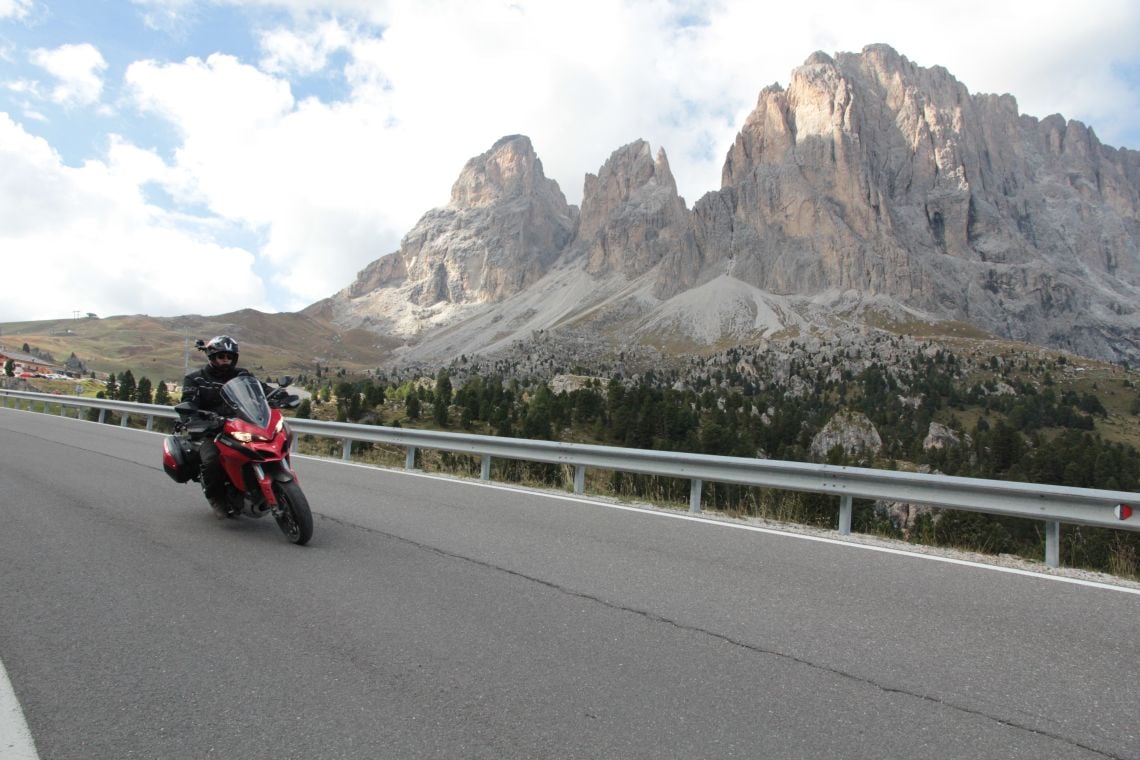
I remember the first time I set eyes on the circular Sella Massif in 1987 as I approached from the Val Gardena in an old transit van. The immense, vertical limestone walls looked unscalable, and yet I was there to climb five via Ferrata routes to the summit plateau, solo.
To familiarise myself with the tasks at hand I thought it best to drive the fabled Sella Ronda, a circular route around the mountain that roughly follows a popular ski touring route and takes in four separate passes; Passo Campolongo, Passo Gardena, Passo Sella and Passo Pordoi. Back in 1987, I owned a yellow and blue Yamaha XT 600 Ténéré and, as the old transit spluttered and groaned around the switchbacks and passes to reveal views more stunning around every turn, I just knew I’d be back to ride these fabled passes on two wheels.
I never did make it to the Sella on the 600 Yam but have done so on a 1990 Kawaski ZX10 and later on a Triumph Tiger 885 Steamer, a Honda Africa Twin, Tiger 955, Yamaha Tracer, Ducati Multistrada and eventually a Ténéré only this model was a 2008 XT660Z. The Dolomites are a biker’s paradise, and in truth, it’s difficult to point to just the one favourite road.
At last count, I had about 30 favourites, but for the purpose of this guide I had to settle on just one and the circular route around the Sella Massif taking in the afore mention passes would be it. The roads are simply superb in the line they take, the condition of the tarmac and the riding demands placed on the rider.
There is not one yard of this 32-mile route that does not delight or inspire or clarify the sheer joy of riding a motorcycle in spectacular scenery. There are too many switchbacks to count, too many highlights to recall and plenty of cafes and restaurants along the way to stop, chill and take in the magnificence of the place.
You’ve probably guessed by now that I’m smitten by both this route and the natural surroundings. And you’d be right. If there’s a downside, it’s that so many other people think and feel similar, which means in the high summer season the roads are going to be busy.
If you have the opportunity to ride the Dolomites in the shoulder seasons then do so, on a Tuesday afternoon in the first week of October we had beautiful blue skies, pleasant temperatures and the roads were as quiet as I’ve ever seen them. Do not hang up your riding boots until you’ve ridden the Sella Ronda.
The Sella Ronda Route
The roads that make up the route: SS48 – SS242 – SS243 – SS244 – SR48
The Four Sella Passes: Passo Campolongo, Passo Gardena, Passo Sella and Passo Pordoi.
Adventure Riding in the Dolomites
There are tracks and trails all over the place around here, but only a few are legal to ride. Here are our top three (for a more detailed description of these passes, along with easy-to-follow directions, head to www.bit.ly/dolomitesoffroad).
The Lusia Pass – Just outside of Moena on the SS346 you’ll find the ski area Alpe Lusia and, just across the road, the start of a gravel trail that heads up through the woods and eventually to the Rifugio Lusia, where you can enjoy the fantastic views with a coffee or snack.
The trail carries on past the refuge down very steep slopes (on our last visit this was the site of a new chair lift for the winter season) into a valley where you can pick up the SS50 to the Passo Rolle. The trail is an exciting mix of dirt and gravel but non-technical.
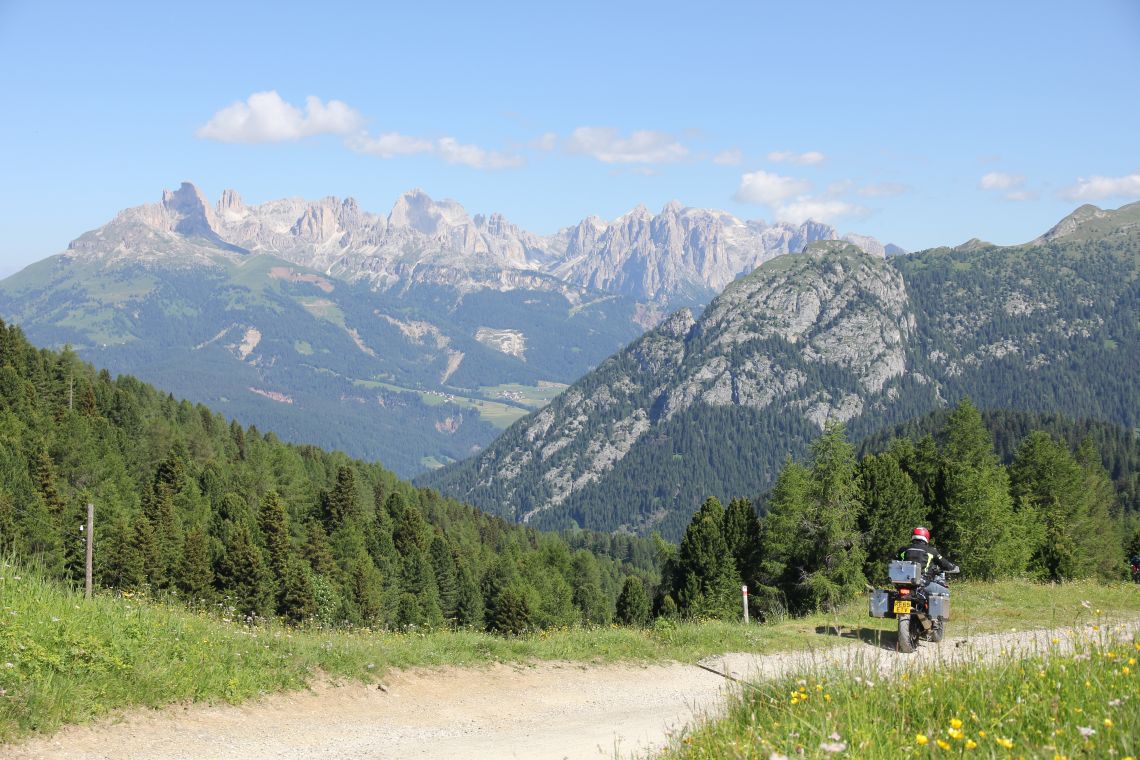
Forcella Lavardet (SS465) – Forcella Lavardet is a fantastic and little-known mountain road in the Italian Dolomites that offers a real sense of adventure. It’s an epic ride along a part tarmacked, part gravel track that features a remarkable staircase of switchbacks that seemingly come out of nowhere.
Out of the small village of Campolongo, you’ll want to head south along the SS465, though at this stage it looks like nothing more than a gravel access track. The deeper you go, the more it feels like you’re heading into the wilderness and the track looks more disused.
Big adventure bikes will have no trouble on this route, providing it’s dry, and the reward is a special, adventurous ride through stunning Alpine scenery.
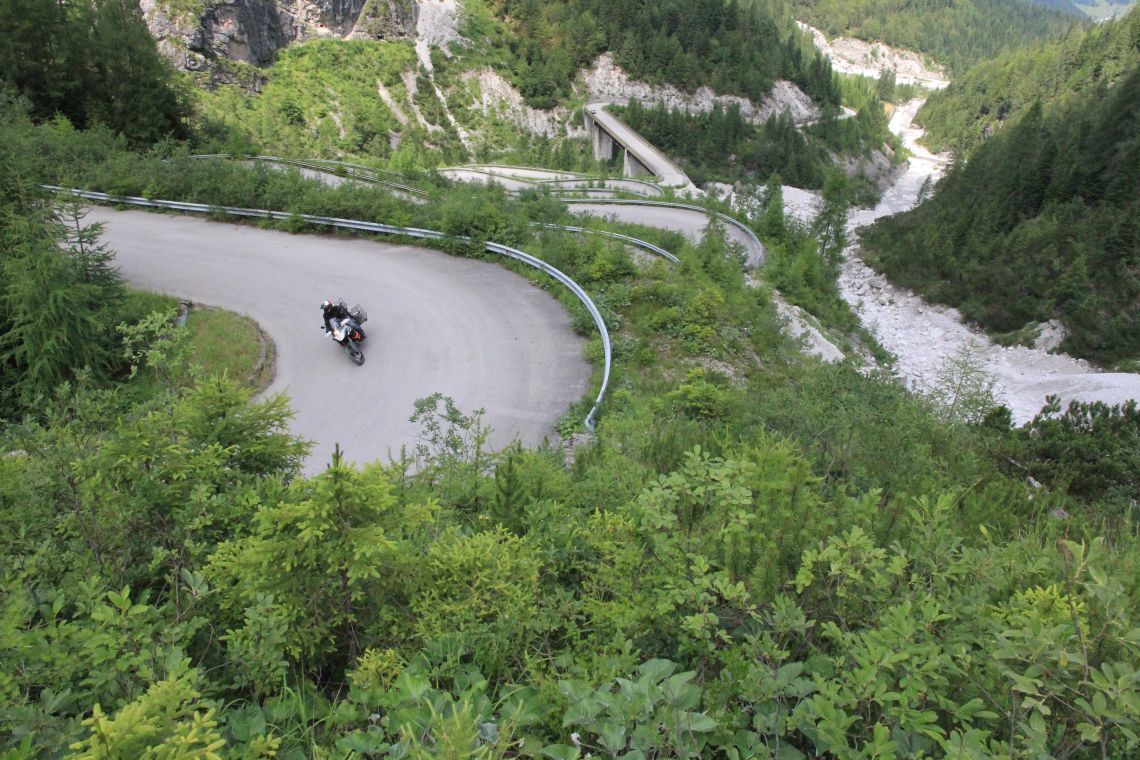
Passo Della Forcella – For a real sense of isolation, remoteness and awe-inspiring views, Passo Della Forcella is one of the Dolomites’ best motorable passes. Dirt track on its southern flanks, tarmac to the north, the lonely road links the two small villages of Lateis, near the shores of Lago di Sauris, and Mione.
It appears that this incredible road is now used mostly as an access track to an isolated farm that sits near the pass’s summit, but while it might be some farmer’s daily route to the shops, for the adventure bike rider it promises epic riding.
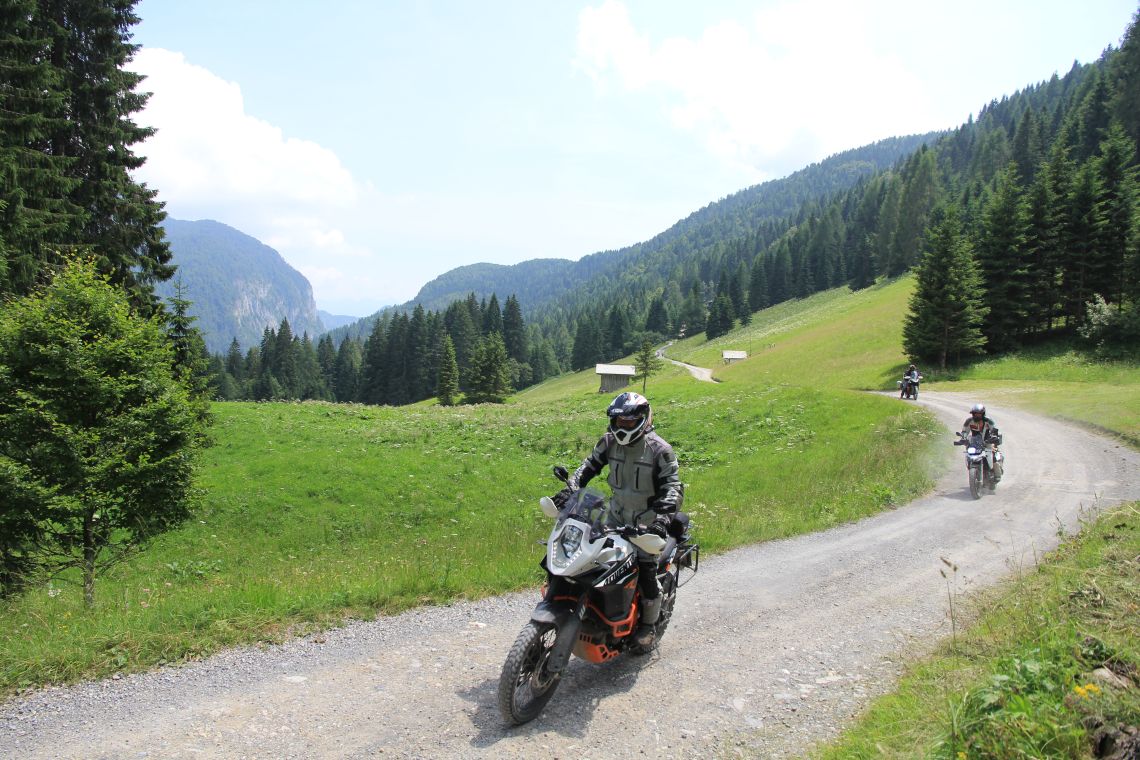
For the most part, it’s beginner-friendly, though there are some deep water channels cut into the road that you’ll need to negotiate. Any struggles are well worth the effort, as the views for the duration of the ride are special and offer a view of the Dolomites that many will never see, particularly the panorama from the summit.
Make sure your brakes are in full working order, as the descent into Mione has a gradient of 28% for a few miles.
Central Italy
Emilia-Romagna, Tuscany, Umbria, Marche, Lazio and Abruzzo
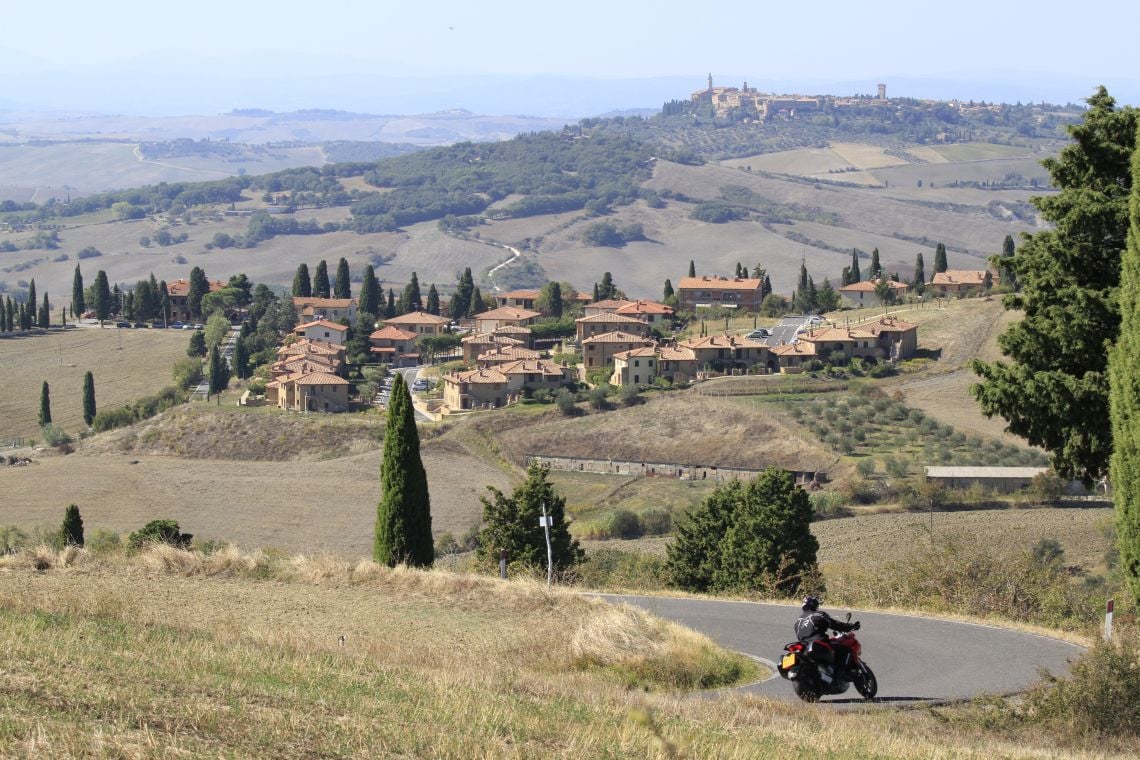
Where is it?
For the purpose of this guide, Central Italy comprises of the following regions: Emilia-Romagna, Tuscany, Umbria, Marche, Lazio and Abruzzo. Essentially, we’re looking at the region from the flat Po Valley in the north, down mid-way between Rome and Naples Riding from Venice to Bologna after descending out of the Dolomites, you could be forgiven for thinking ‘well that’s the end of the interesting roads in Italy’, but nothing could be further from the truth.
As you approach Bologna the land starts to undulate and rise as you head into the Apennine Mountains, which run for 750 miles down the length of Italy.
The Apennines are a series of mountain ranges that form the backbone of the Italian peninsular, stretching from the coastal region of Genoa in the north and following a broad arc to the tip of the Italian toe at Reggio Calabria in the south.
The highest summit of Corno Grande (2,912m) tops out in the Abruzzo region where should you be touring in winter, you can ski and ice climb as I’ve done a few times in years gone by.
However, when in Bologna you must set aside some time for a visit to the Ducati museum where you can take a factory tour. You don’t need a prior booking for the museum, but you will need to book in advance if you’d like to go on a factory tour.
At the time of writing, the factory is closed to visitors on Wednesdays and weekends, so you’ll need to bear that in mind when planning your trip.
Check out www.ducati.com for up-to-date details, timings and prices.
Heading south from Bologna towards Florence, you really can’t go wrong. The whole region is full of winding mountain roads through a landscape rich in history and archaeology. However, my personal favourite involves a route that takes in the Raticosa and Futa passes and a pass by the famous Mugello Circuit, where the Italian MotoGP is hosted.
Be warned though, this route, especially from the Raticosa via the Futa and onto Lake Bilancino near Mugello, is as close as you’re likely to get to competing in a road race. If I said to you that, on a good day, this stretch of tarmac is the Italian equivalent of Mad Sunday at the TT, I’m sure you’ll get the picture.
These passes are incredibly popular with motorcyclists that appear to have a point to prove and it’s not that they enjoy a slow sight-seeing bimble. That said, it’s a thrilling ride with endless, sweeping turns and it’s not to be missed when passing through the area on route to the spectacular city of Florence.
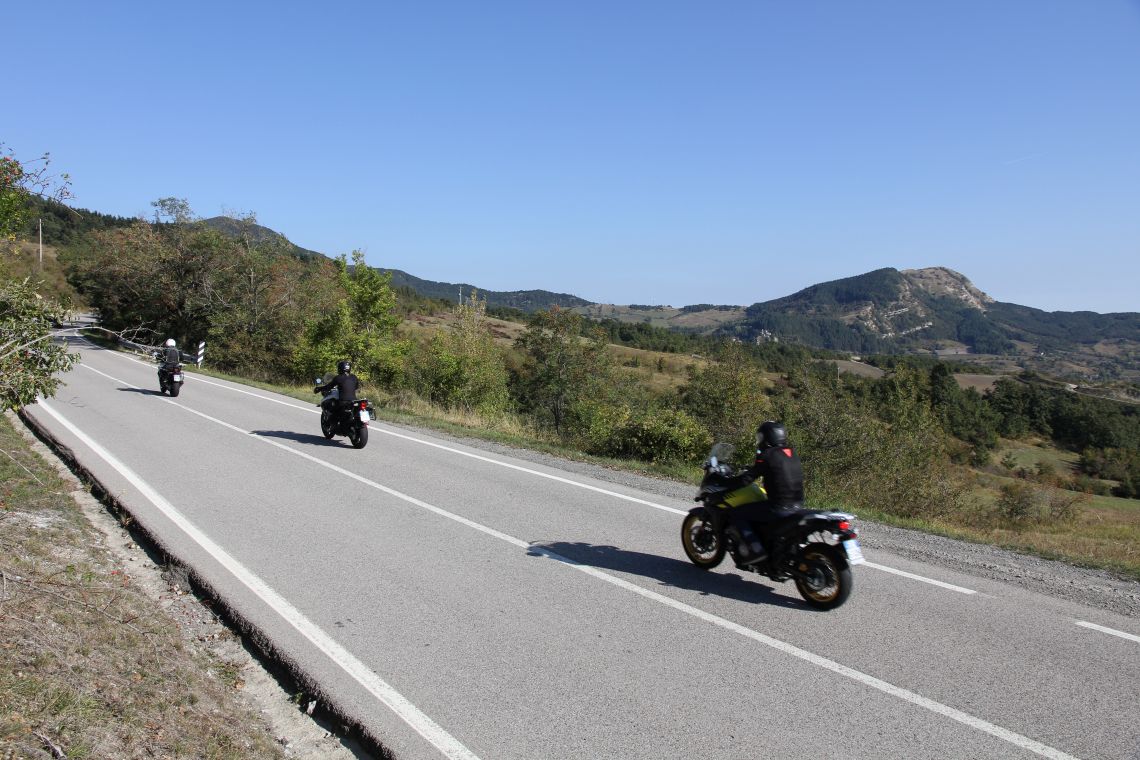
If you’re anything like me, city tours do not feature highly in my motorcycle touring plans, but I make an exception when touring Italy. Venice is a must-see, as are the sights of Rome and Pisa, if only for the Leaning Tower in the case of the latter. If you only have the time or patience for one city visit, then make it Florence.
Florence is a work of art. Its cathedral and baptistery are magnificent as is the Piazza Della Signoria, the Ponte Vecchio bridge and Medici Riccardi Palace. On the downside, they will be teeming with tourists.
There are also excellent museums that house many world-renowned paintings and sculptures including perhaps the most famous sculpture in the world, Michelangelo’s David, and Botticelli’s Birth of Venus.
At the very least, it’s worth parking up the bike for a day and checking out this amazing city and its sights and treasures. Anyway, enough of this culture, let’s get the show back on the road and head further down into Tuscany.
Historically, my visits to Central Italy have been dictated by my climbing gene so I would set course for the areas of highest elevation and therefore ride down the east of Tuscany and into Marche and Abruzzo before swinging right and heading into Rome.
Over the past 10 years, I’ve mellowed out a touch and have tended to take the more cultured approach down through Tuscany. Setting out from Florence via Siena, it would be a mistake not to check out the famous historic centre and majestic Piazza del Campo the setting for the famous Palio di Siena horse race, which is held twice each year; 2 July and 16 August if you happen to be in the vicinity.
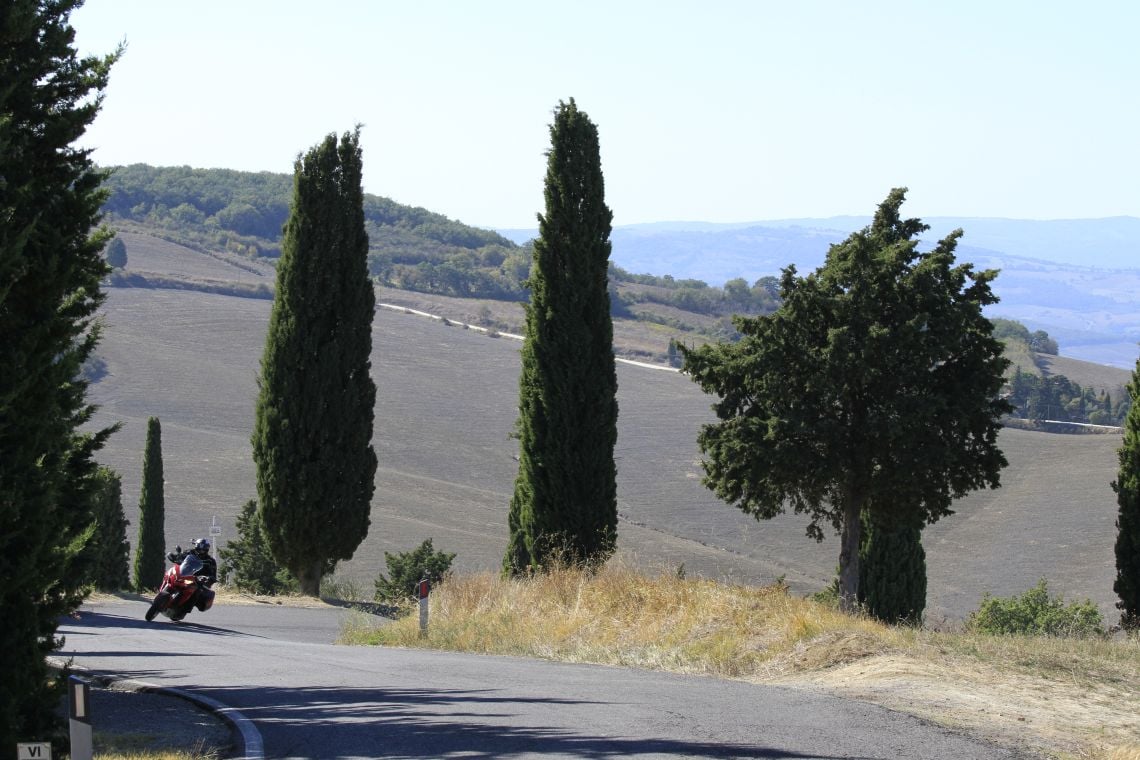
From Siena, we set a course through the picture-postcard Tuscan scenery to Montepulciano, a well-known Renaissance hill town that’s famous for its red wine. If you have the time, it’s worth parking up the bike and walking through the car-free streets to the Piazza Grande at the top of the hill.
From Montepulciano, it’s a short hop and skip to the town of Pienza, another classic depiction of the Tuscan hilltop commune.
Pienza has been declared the ‘touchstone of Renaissance urbanism’ and, in 1996, UNESCO appointed the town World Heritage status and it’s well worth stopping off for a coffee in its bustling historic centre. The scenery around Pienza and Montepulciano is classic Tuscan rolling hills with towns and villas cresting the higher elevations with many featuring vineyards.
The roads in the region are full of twists and turns and are generally open with great onward visibility as they follow the contours of the land, but they could pretty much all do with a new coat of tarmac.
‘Rustic’ is probably the appropriate word to describe the road conditions in this delightful location, and if your heart desires, there’s a huge network of gravel trails. As we head south from Pienza I’m going to implore you to do two things: check out the Val d’Orcia and stop off at Bagno Vignoni.
The Val d’Orcia is a beautiful valley of rolling hills, vineyards, Renaissance villages and atmospheric zig-zagging roads lined with cypress trees with the most famous being the road up to Monticchiello. I guarantee you’ll not be able to resist a photo stop.
And just before we settle down for a long thrilling ride down through Central Italy there’s one more stop off a few miles down the road from Monticchiello which is once again guaranteed to have you scrambling frantically for a camera.
I first set eyes on the main square of the small 16th-century village of Bagno Vignoni on a cold, dark evening during the launch of a new Ducati motorcycle. The sight before me was both surreal and breath-taking.
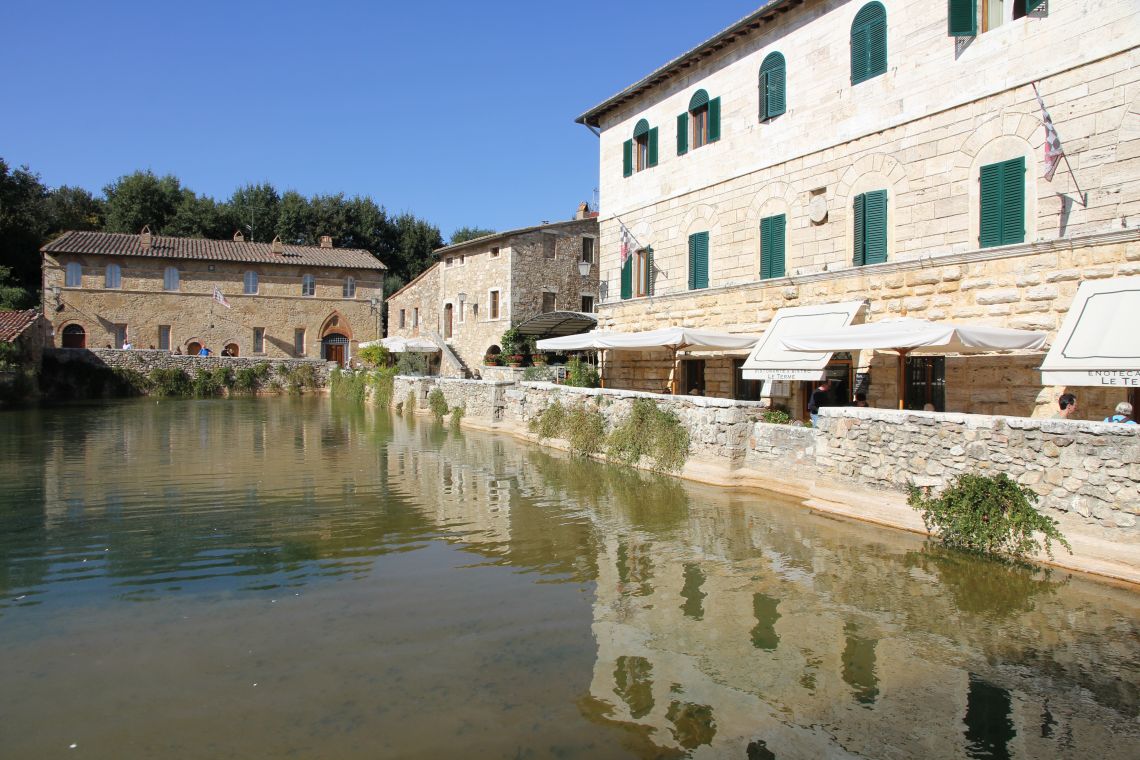
The whole of the village square (about the size of a five-a-side football pitch) is a sixteenth-century (though the spring was used thousands of years prior), walled-in hot bath fed by warm waters from a spring and there, in the middle, ‘walking on water’, was the new motorcycle enshrouded by an eerie Ducati red. Bikes in the bath or not, Bagno Vignoni is not to be missed.
If it were not for a planned detour over to Sardinia, my route south from Tuscany would have looked like this; a ride through the high mountains of the Gran Sasso and Abruzzo National Parks followed by a ride up my favourite road in the region, the SP10 on Monte Terminillo.
It’s a fantastic road full of tight zig-zags and sweet curves up a high 2,000m-plus mountain. The scenery is spectacular, and it never fails to amaze me that in years gone by I’ve found myself ice climbing on a high, exposed snow-crusted ridge within 50 miles of Rome; somehow ice axes, crampons and Rome do not feel as if they should be in the same sentence.
With Sardinia being the main target of this trip, we set a course from Bagno Vignoni to the port of Civitavecchia, just to the north of Rome, careful to avoid any main roads. If you intend to follow our route, you’ll not be disappointed on this ride through the north of Lazio. The roads are spot on, there’s little traffic or tourists and the villages are full of charm and history.
Highlight: The Futa Pass
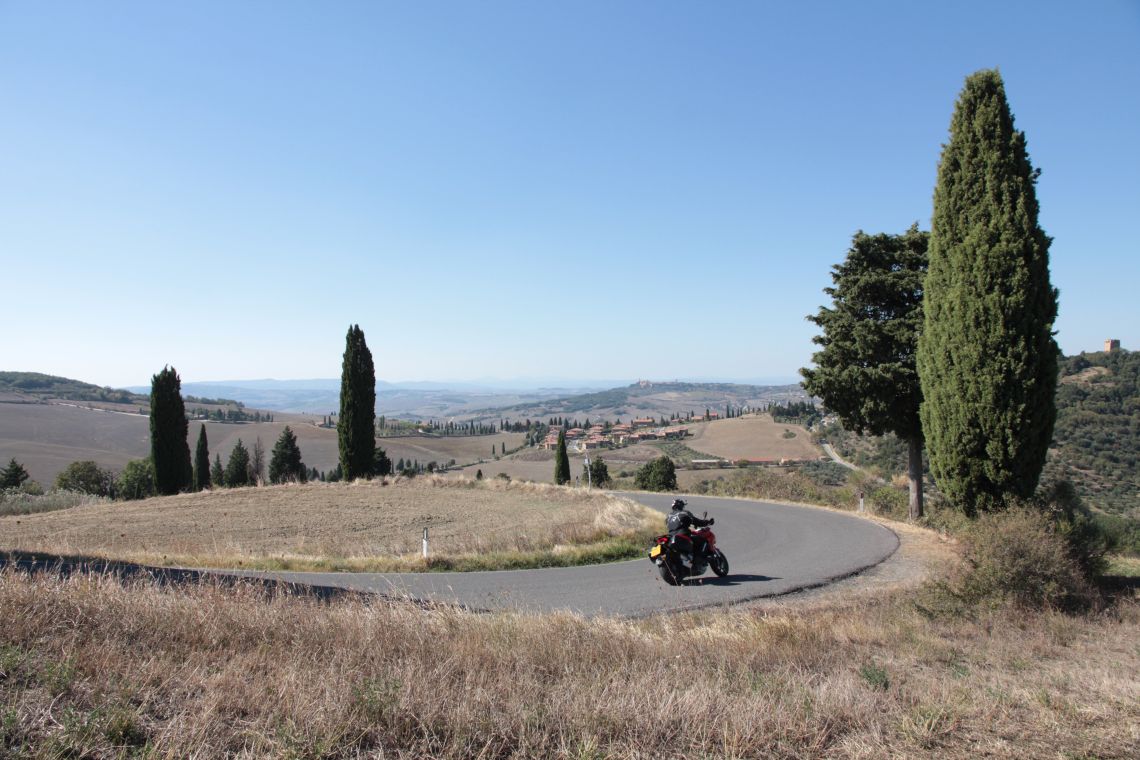
When I asked the locals at Ducati which road or route they would recommend south of Bologna, the reply was unanimous; The Futa Pass. The Futa has gained legendary status amongst bikers in the area and, in all our travels through Italy, I don’t think we came across a road so dominated by motorcycles.
When we travelled through, I’d say that for every car there were 30 or more bikes blasting their way over the pass. The other point of note was the nature of the bikes and riders. Whilst adventure bikes had been the dominant breed on every other road we’d travelled in Italy, the Futa is a mecca for sports bike fans and, with the home of Ducati just to the north and the Mugello Circuit nearby, maybe that should have been no surprise.
The pass tops out at 903m and the road to the crest is, I have to admit, just made for opening up. Fast sweepers, tight hairpins, chicanes, undulations, short, sharp sections… It’s a wonder they bothered making a purpose-built track so close when the Futa was on hand.
What I also liked about the place was the casual way the village folk just did not bat an eyelid when a group of 20 howling sports bikes came screaming through their little communes. But then, when it’s an everyday event…
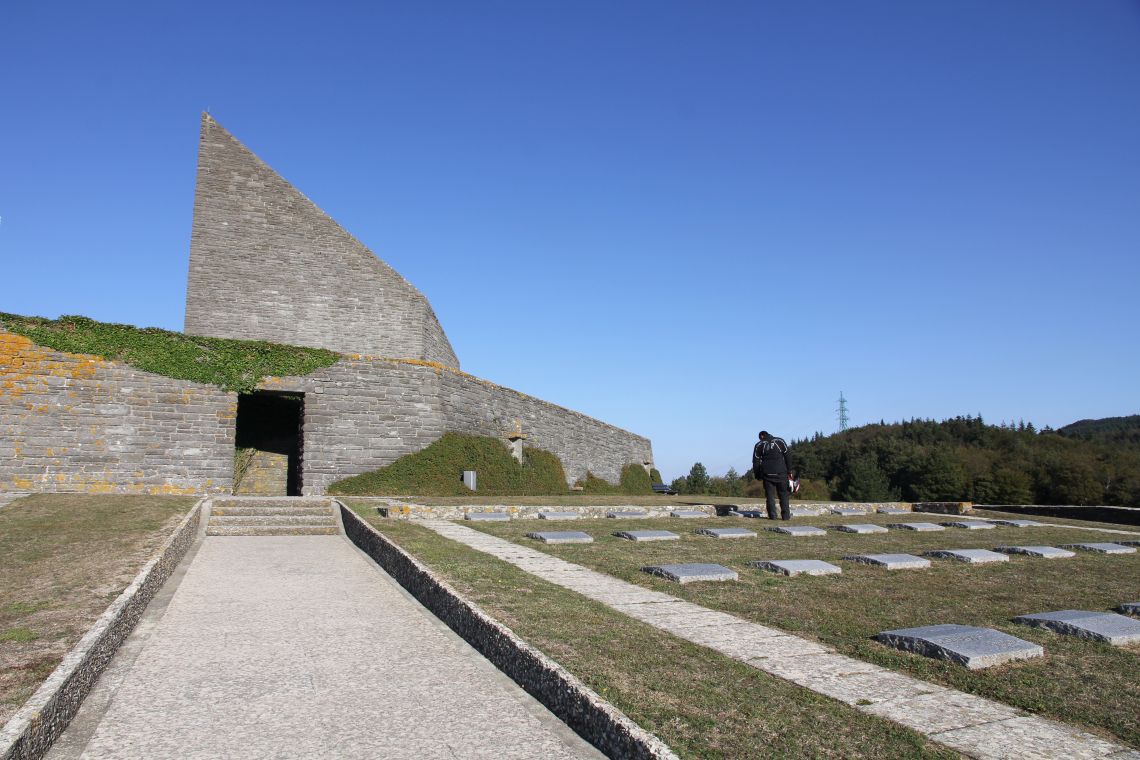
Aside from the motorcycle interest, the Futa was a major part of the Gothic Line during World War Two where the Germans made their last defensive stand against the advancing allied forces. There’s a well-tended German military cemetery at the top of the pass that’s worth a visit.
Southern Italy
Molise, Campania, Apulia, Basilicata and Calabria
Often overlooked due to time constraints, Southern Italy is a playground for motorcyclists. From the spectacular Amalfi Coast to the troglodyte town of Matera and Aspromonte National Park in the deep south, the feeling of being on an adventure is guaranteed.
Where is it?
For the purpose of this guide, we’re talking about the regions of Molise, Campania, Apulia, Basilicata and Calabria. Think of all the area below an imagined line drawn across the country mid-way between Rome and Naples, or the lower shin, ankle, heel and toe. The Gulf of Naples also called the Bay of Naples, is a spectacular sight.
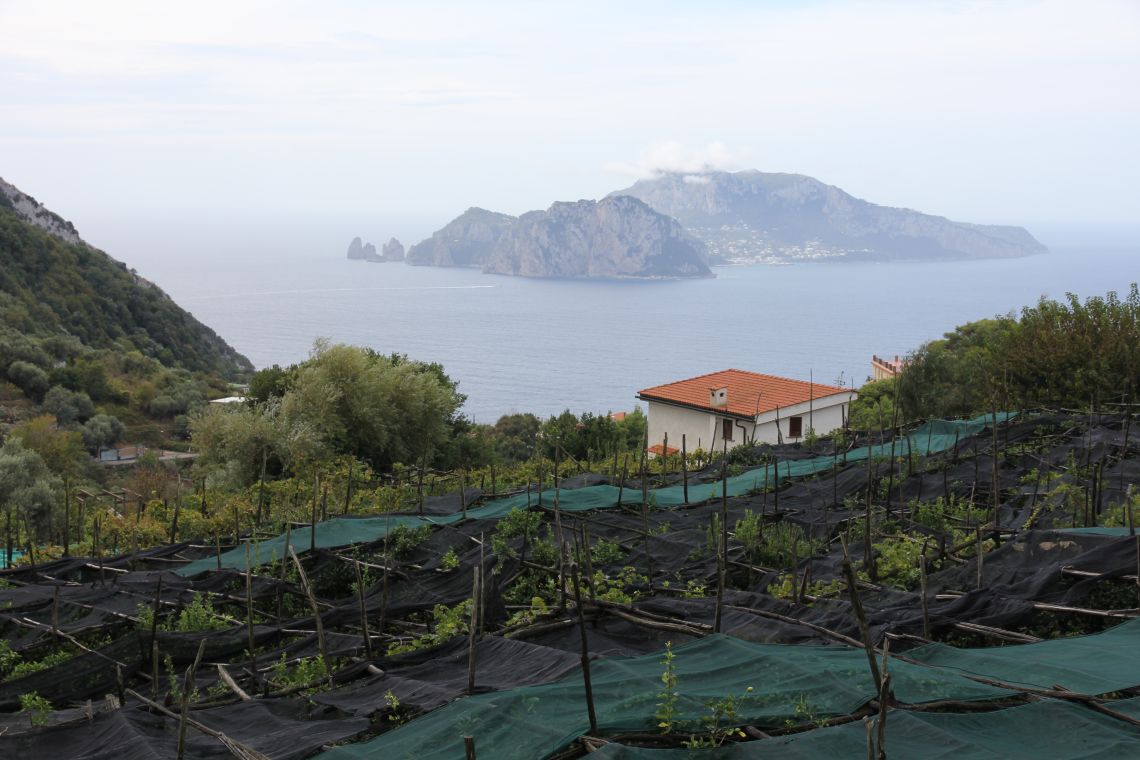
Bordered on the north by Naples with Vesuvius in the East and the Sorrentine Peninsula and the Isle of Capri in the south, it looks all the more impressive when you arrive by boat in the early morning. It’s a 14-hour overnight crossing by ferry from Cagliari in Sardinia to Naples on the mainland, with the regular docking time of 9 am.
The early morning arrival by sea, if the weather allows, means you get a great perspective of just how huge and threatening Vesuvius actually is and time to contemplate the writings of Pliny the Younger, the only surviving eyewitness to document the eruption of AD79 which buried the nearby towns of Pompeii and Herculaneum.
Make the most of this peaceful pondering time for, once disembarked in Naples, the world turns manic and chaotic. I’ve talked to some who would advise staying well clear of the commotion of driving in Naples, but I have to say I actually liked it.
You’ll have to keep your wits about you and a keen eye on every other road user and pedestrian within sight, but there is something quite charming and exciting about this southern Italian city which I reckon should not be missed.
And the road manners do not improve as you head south past the ancient Roman city of Pompeii which was preserved under 6m of volcanic ash and pumice in the eruption of AD79. It’s an incredibly busy tourist attraction but also one you’d regret not taking time to park up and explore.
From Pompeii we continued south-west through the equally busy and charmingly chaotic Sorrento and followed the road to the village of Termini, the last village on the Peninsular before the land drops dramatically into the sea, the isle of Capri sitting pretty a few miles off the coast.
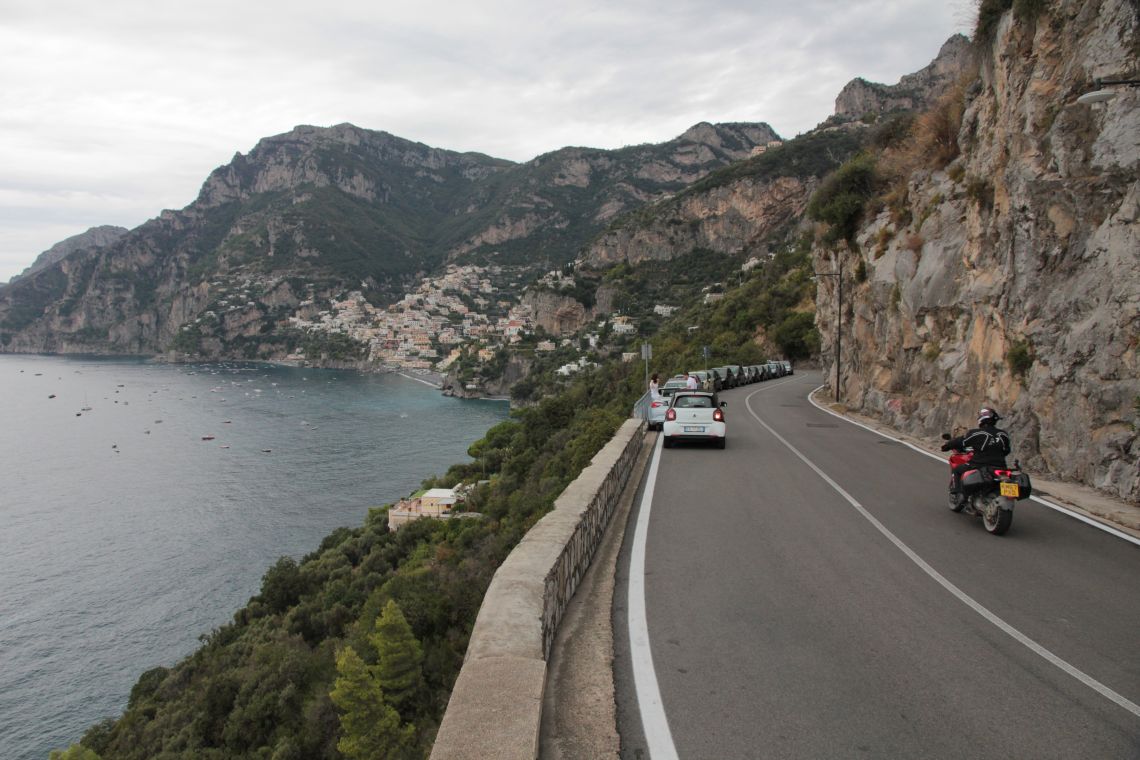
After a quick coffee we were off to ride one of the most spectacular coastal roads in the world let alone Italy. The Amalfi Coast is world-renowned for its dramatic beauty and is yet another Italian spectacle listed as a UNESCO World Heritage Site.
The narrow road follows a 32 mile stretch of coastline along the steep and precipitous edge of the Sorrentine Peninsular. In parts, it’s cut out of vertical cliff faces which plunge into the sea below and it is a very popular tourist destination which all means it can get hugely busy in the prime summer months.
On a previous visit, my objective was to park up for a few days and check out the spectacular hiking trail called ‘The Path of the Gods’ which kicks off in Positano and follows an audacious line across the huge cliff faces – if you fancy it you’ll need a head for heights. If it were not for the number of cars and tourist buses on this narrow, winding road it would be a fantastic riding experience.
But do not let the thought of congested roads put you off, the natural and manmade sights on this route are outstanding and non more so than the pastel-coloured fishing villages, grand villas, terraced vineyards and lemon groves which cling to the precipitous shoreline in outrageous positions and locations.
I guarantee that a trip down the Amalfi Coast is impossible without the thought of ‘who the hell would have thought of building that there?’ a constant companion.
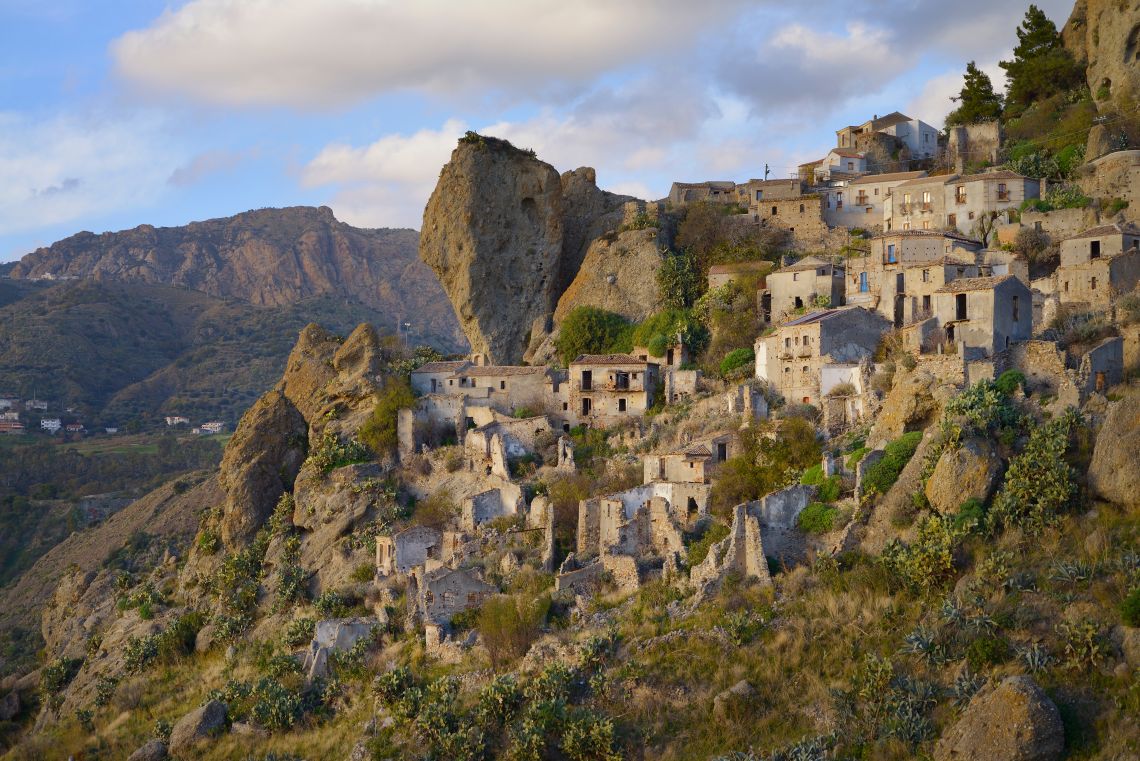
Heading south from Salerno, the city which marks the end of the Amalfi Coast, there are numerous options to continue with your Grand Tour of Italy, though I would suggest avoiding the main roads and just taking your time to explore the culture and sites en-route to Sassi di Matera, otherwise known as the ‘Underground City’ which has been in constant habitation since the 10th century BC. The historical centre is yet another UNESCO Site.
Travelling on down to the toe of Italy from Matera, take a small diversion to the remarkable and haunting old ‘ghost town’ of Craco and stay on the SS103 to witness one of the most extraordinary civil engineering projects I’ve come across.
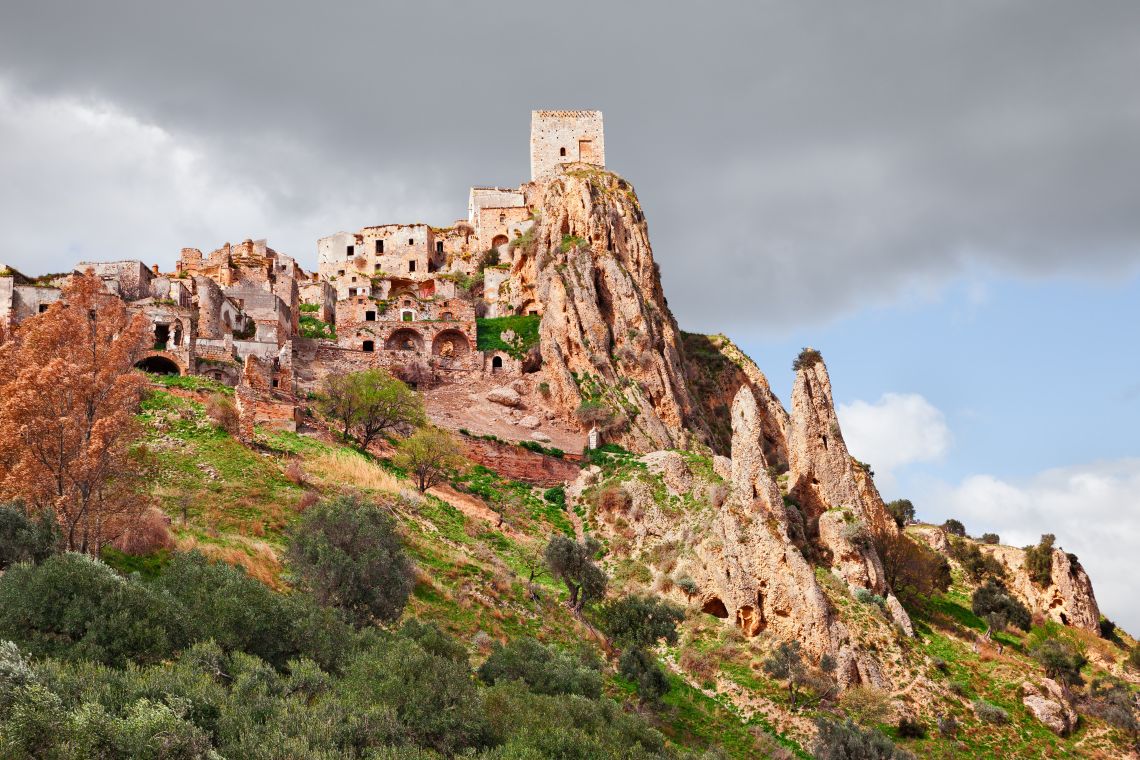
In the middle of nowhere, the SS103 has been raised over the surrounding countryside on stilts where there is no logically apparent reason to have done so. If time allows, the roads and trails in the Pollino National Park make for superb motorcycle territory and the sights within what is Italy’s largest national park come as a bit of a surprise being this far south.
The highest peak in the park is 2,267m (nearly 1,000m above the UK’s highest summit, Ben Nevis) and it’s famous for hosting the oldest scientifically dated tree in Europe, a Heldreich’s pine aged 1,232-years-old. And just before you head on over to Sicily, make time to ride a couple of roads or trails in the Aspromonte National Park right in the toe of Italy’s boot.
It’s another spectacular region featuring high mountain roads and remote villages. In days gone by this remoteness meant that the region was used by the local Mafia, the ‘Ndrangheta, as an ideal hiding spot for contraband and victims of kidnap.
There’s no need to worry now though, the park is both tourist and biker friendly. From the park, it’s no more than a two-hour ride to the port town of Villa San Giovanni where there are multiple crossings per day into Messina on Sicily.
The crossing is just shy of four miles and takes approximately 20 minutes. You do not have to buy a ticket in advance and, as of writing this, the one-way cost for a motorcycle crossing is €7.
Sardinia and Sicily
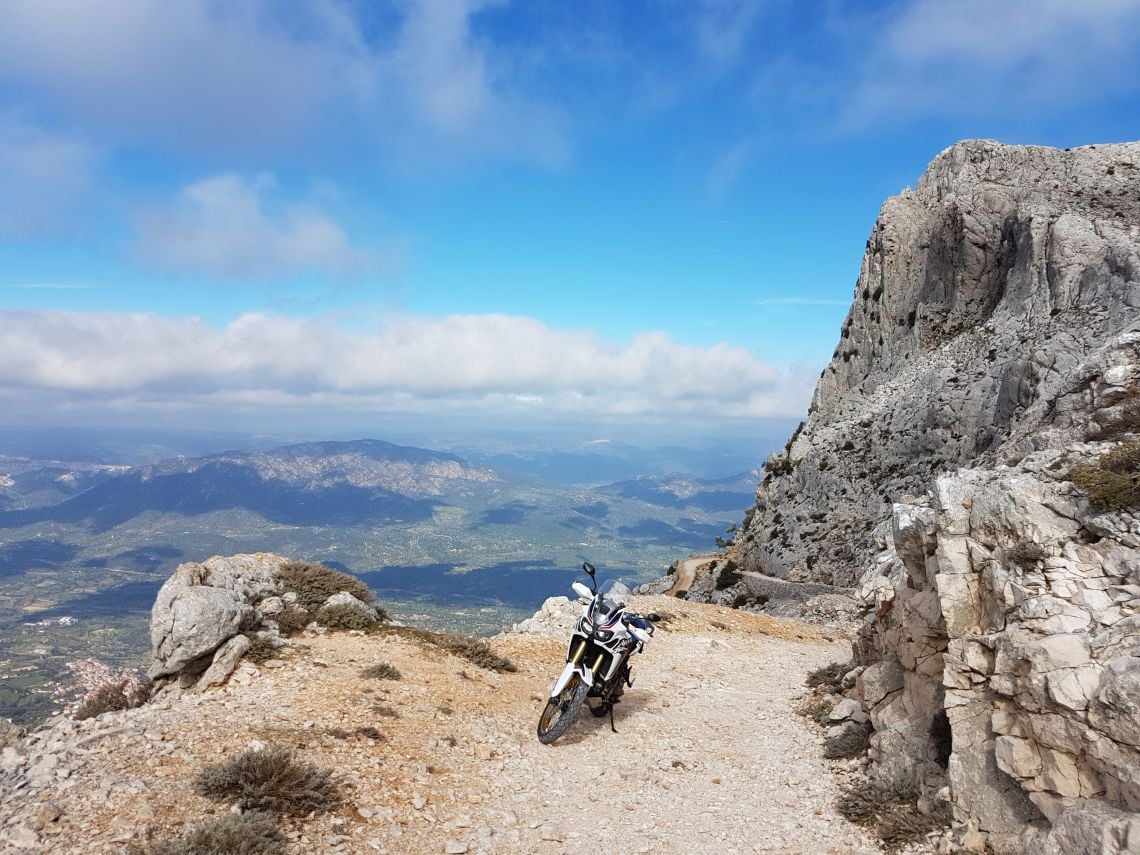
Sardinia
The crossing from Civitavecchia on the mainland of Italy to Olbia in the north of Sardinia is convenient for a number of reasons. First off, it’s an eight-hour overnight sailing and there are comfortable bunks, so you don’t lose any riding time and arrive early morning good and fresh.
Secondly, there are daily overnight sailings from Cagliari in the south of the island to Naples on the mainland which means you can tour from north to south (or vice versa) without backtracking.
Prior to our 2018 trip, I’d spent time on Sardinia riding, hiking and climbing throughout the country. From the magnificent SP71 coastal road down at the very south of the Island right up to the tip of the Punta Marmorata peninsular up north.
However, as is usually the case, it’s the regions with high rugged peaks that tend to draw me back and that was the case on this occasion. If you’re going to tour Sardinia and your idea of an adventure ride includes off-road trails, then you just have to head to the mountain village of Oliena near the island’s highest peak.
Once there you’re going to need to find the hotel and restaurant Albergo Monte Maccione.
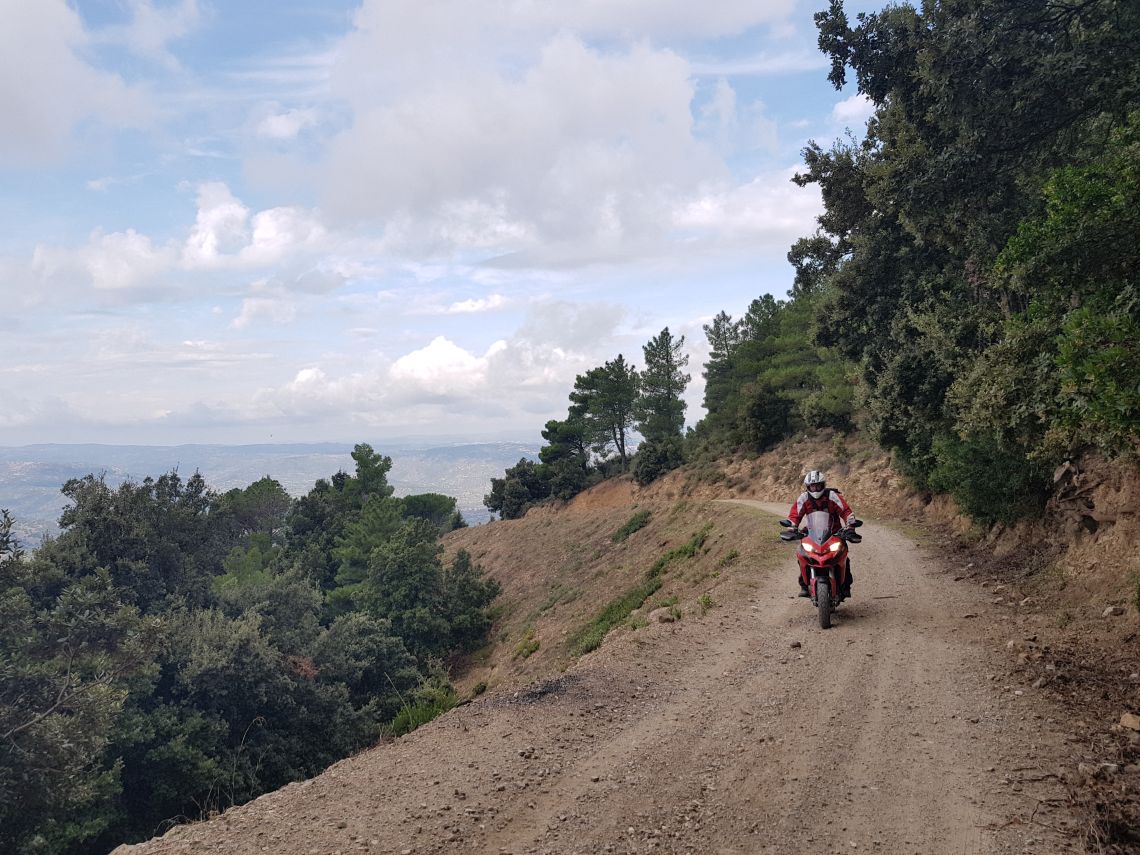
The hotel is on the mountainside way above the village and the ride up is all tarmac but be prepared for an outrageous sequence of hairpin bends, I counted 18 within a single mile. It’s worth popping in here for a coffee even if you have no intention of riding what comes next.
From the hotel, follow the road until it turns into a trail and take the next right. From this point on you’ll need to have off-road experience and a good head for heights as the trail ascends the high rock face ahead, the Punta Corrasi.
This trail is a fantastic adventure experience and whilst I’d not class it as highly technical (if you’re competent riding rocky trails, you’ll be OK) it does require a cool head and safe hands especially if you are riding a big, heavy adventure bike.
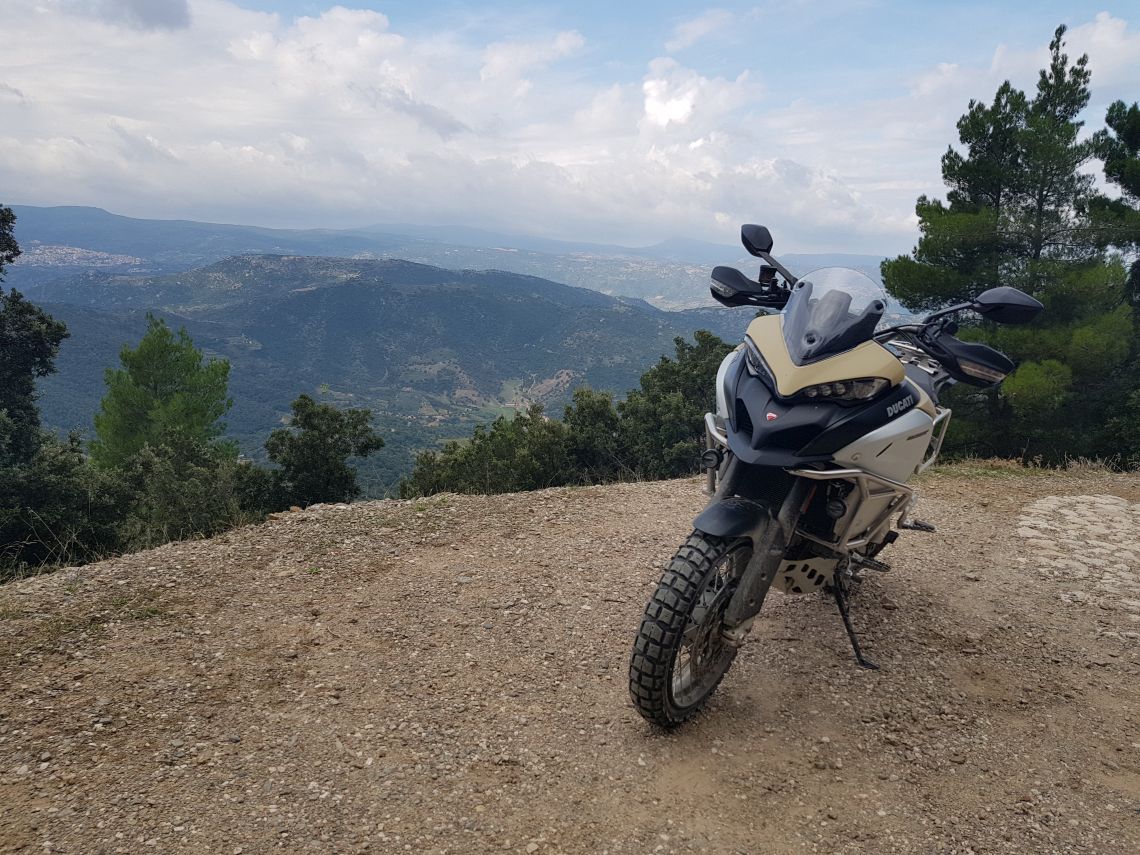
On this occasion, we did not reach the top due to a landslide about 200 metres from the summit but having been up the trail two years previous I can’t recommend it highly enough. Go and ride it you’ll be delighted, or terrified, or both. The views from the summit, and as you ascend rapidly up the rock face as outstanding, and it offers a true feeling of adventure.
There’s plenty more to discover in Sardinia with the spectacular coastal region of Cala Gonone nearby, and the dramatic coastal cliffs of Cala Goloritze – last time I was there you could ride down on dirt tracks to viewpoints. And if you’re intending to depart via Cagliari, set aside some time for the SO71 and take a ride over to Sant’Antioco Island via the causeway on SS126.
Sicily
At 3,329m high and covering an area of 459 square miles you simply cannot visit Sicily without seeing the looming presence of Etna, Western Europe’s highest volcano. Well, actually, you can, as we found out the day we sailed into Catania.
As luck would have it, a major storm was blowing in with the focus and epicentre being on Mount Etna. However, we still felt the need to ride up the mountain even if we couldn’t see it, and so we found ourselves at the start of the SP92 loop road in the village of Zafferana Etnea on-route to the café complex near the summit cone at just under 2,000m.
In good conditions, this road up Sicily’s number one tourist attraction would be busy, but during a storm of tropical proportions in the first week of October we had it all to ourselves – that must be a first.
We arrived at the highest car park with its numerous bars and restaurants looking a little forlorn as the main storm event started to batter the mountain. Apart from a single Russian tourist, we were the only other people in town. After a quick coffee, it was back out into the thunder and lightning for a ride down the south side of Etna to the village of Nicolosi.
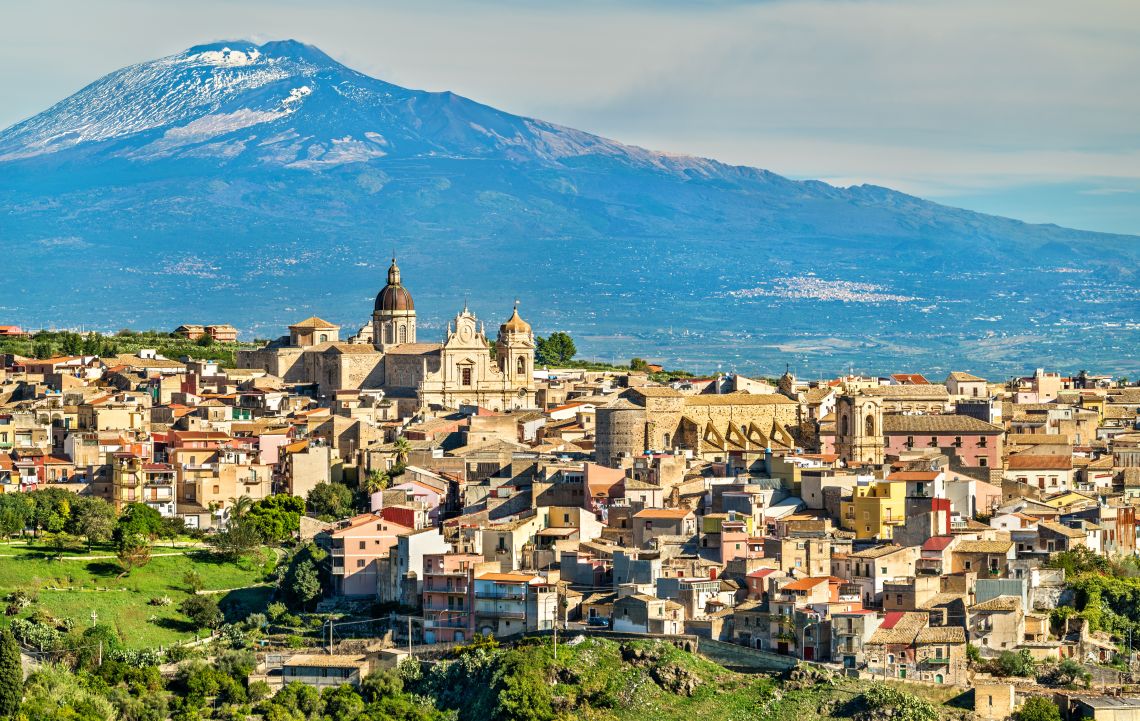
We had one brief period when the cloud lifted to reveal the old lava fields we were travelling through, but other than that it was torrential rain which translated into two-inch deep rivers flowing down the roads by the time we were coming off the mountain and flash floods appearing all around.
The conditions made the trip up Etna a lot of fun but having been previously in clear, warm weather I have to say the latter is preferred to be able to view and absorb the stunning scenery and extent and power of previous lava flows.
Leaving the east coast of Sicily and heading inland, a tour of this island would not be complete without setting course for the town of Agrigento on the south coast. You’ll get to experience the interior of the island and just outside the town of Agrigento you’ll find the most visited historical site on the island; the Valley of the Temples.
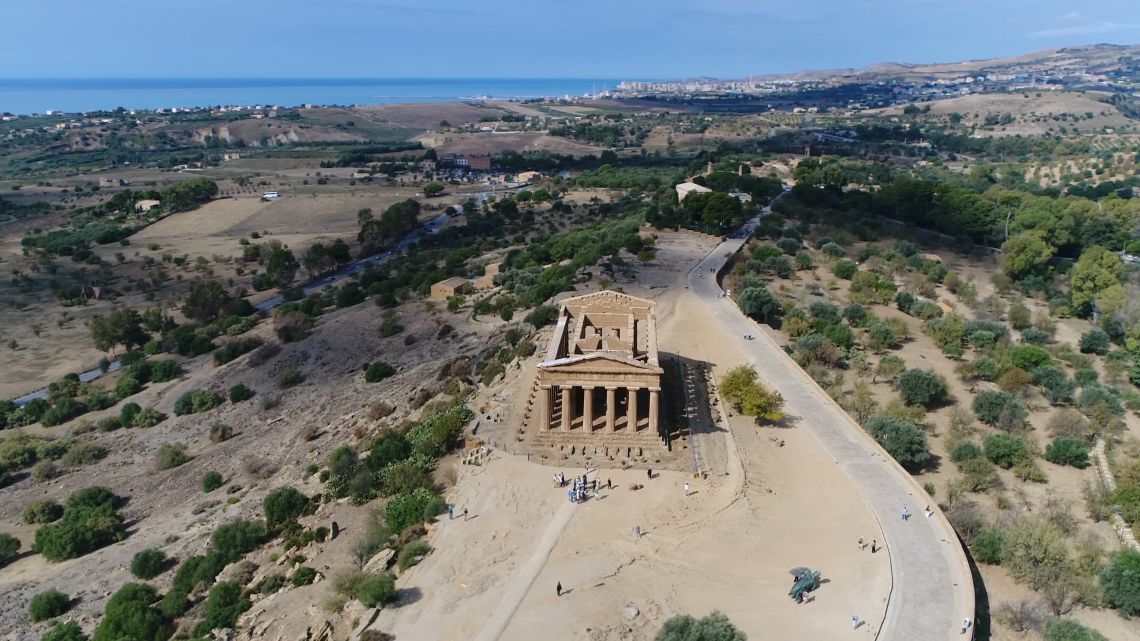
The Valley is a UNESCO site and includes the remains of seven well-preserved temples including the Temple of Concordia, an ancient Greek temple built between 440-430BC, which is noted as the best-preserved example in the world other than the Parthenon in Athens.
Heading north from Agrigento you’ll find roads going through the most mountainous part of the interior all the way to the regional capital of Palermo, which you may be surprised to know is the fifth most populated city in Italy.
It was here that we finished our trek down through Italy when we boarded a 24-hour ferry back to Genoa on the northern Mediterranean coast. A sailing which allowed us to arrive back in northern Italy relaxed and refreshed having saved over 800 miles and two big days of motorway travel.
Getting There
The quickest route into Italy from the French port of Calais is via the A26 motorway toll road (also known as Autoroute des Anglais, or Motorway of the English) down through France and crossing the border at the Mont Blanc Tunnel into Courmayeur. It’s a ride of approximately 560 miles and the current toll charges for motorcycles works out at €66.
Ferries
If you want to visit the Italian islands of Sardinia and Sicily, then you will need to take a ferry. If time is an issue, you can ride the length of the country and return from Sicily to Genoa on the 24-hour ferry out of Palermo. It’ll save you around 800 miles of riding.
To give you an idea of ferry costs (rider plus motorcycle), a return trip to Sardinia from Civitavecchia (near Rome) to Olbia in the north of the island and returning to Naples on the mainland from Cagliari, will cost in the region £100. Cabins cost extra.
A one-way ticket from Palermo, Sicily to Genoa is approximately £90. Four-bed cabins cost in the region of £50.
Please note that the above prices are correct at the time of going to print but do vary on the season and availability.
Driving Regulations
Area: 116,338sq miles
Population: 60,600,000
Capital: Rome/Roma
Currency: Euro
Website: www.italia.it
Speed Limit:
– Motorway – 130km/ph (80mph)
– Dual Carriageway – 110km/ph (68mph)
– Single Carrigeway – 90km/ph (55mph)
– Urban – 50km/ph (31mph)
A national vehicle identification plate is always required when taking a vehicle abroad. Italy requires visitors to carry a valid passport, vehicle registration document, letter of authority if you are riding a loan bike, full driving licence and insurance documentation.
It is compulsory for all riders and pillions to wear crash helmets and to carry a reflective vest to be used in the case of a breakdown. It’s also worth checking up on the French legal requirements regarding the minimum amount of reflective gear you may need to wear when travelling down through the country.
Riding Tips
When riding in Italy you can expect the following:
1. After overtaking, Italian drivers tend to pull in in front of you a lot sharper than UK drivers.
2. Motorway slip roads tend to be a lot shorter than in the UK, so you’ll need to build up your speed quicker to join the fast-paced lanes.
3. Many petrol stations are unmanned and for the UK rider can be very confusing to operate – it’s not uncommon to pay for the fuel at a different pump to the one you’re parked at.
4. On many occasions, we’ve found that on-screen speed limits on SatNavs bear no resemblance to those on the ground.
The bikes
When in Italy… ride a Ducati. We’d like to offer a big thanks to Ducati for supplying the two bikes used on our Grand Tour of Italy. We chose the Multistrada 1260 along with the more off-road orientated Multistrada Enduro Pro.
Both of these bikes proved to be excellent, reliable and comfortable companions on our trip from the high off-road passes in the Alps, to the twisty hairpins of Tuscany and the remote interior roads of Sicily. As the saying goes… We couldn’t have done it without them.
